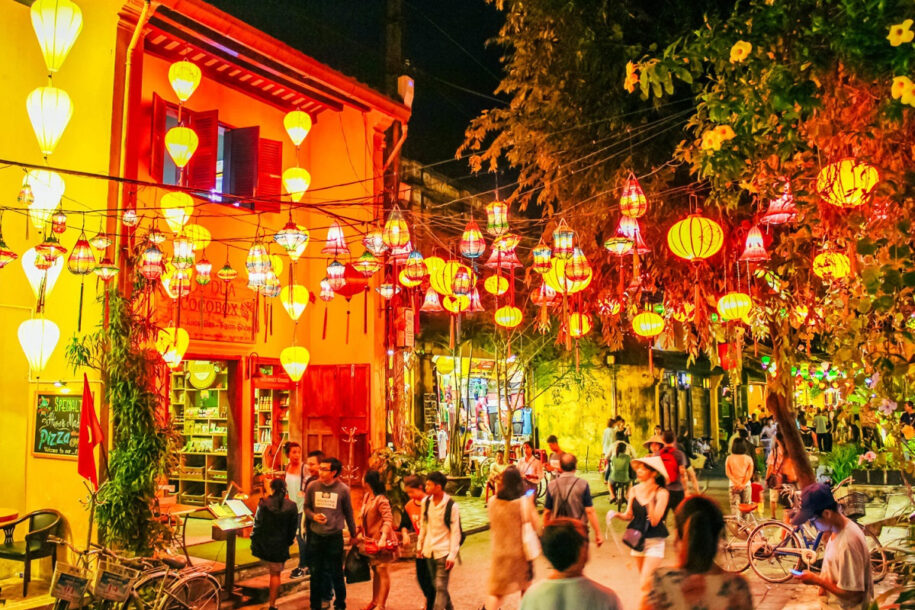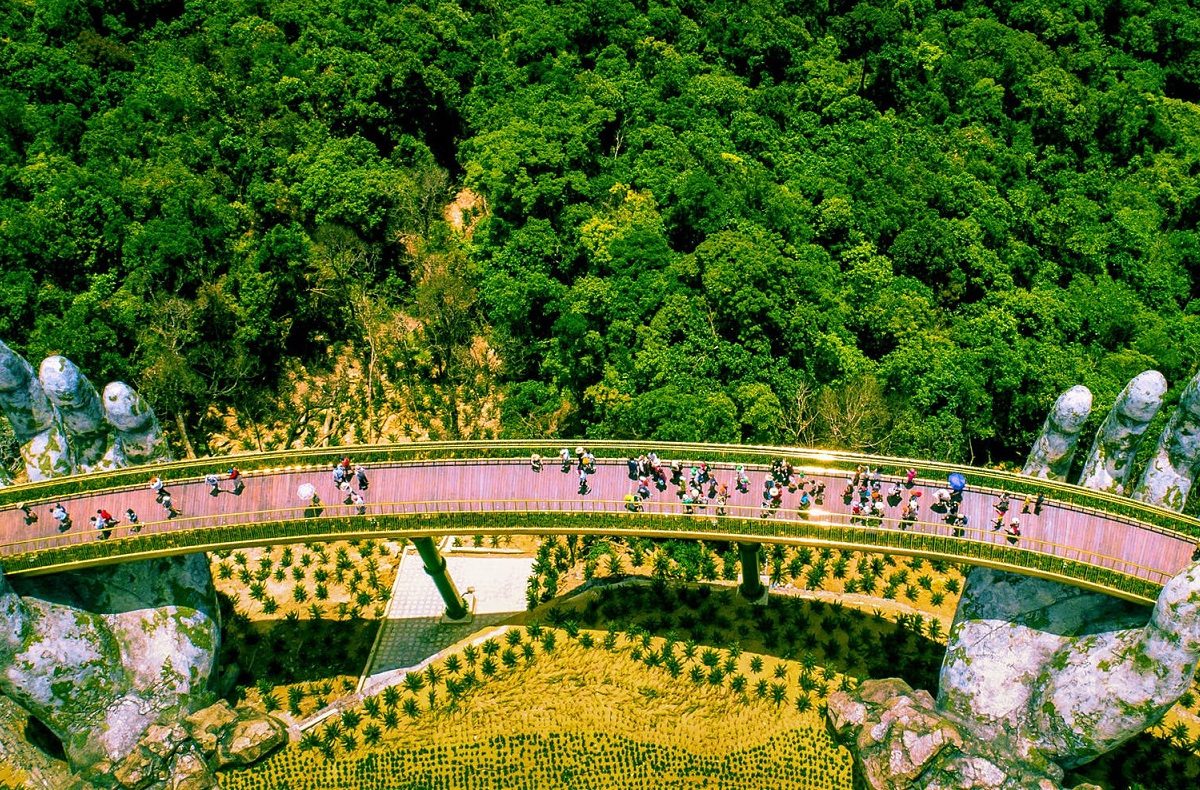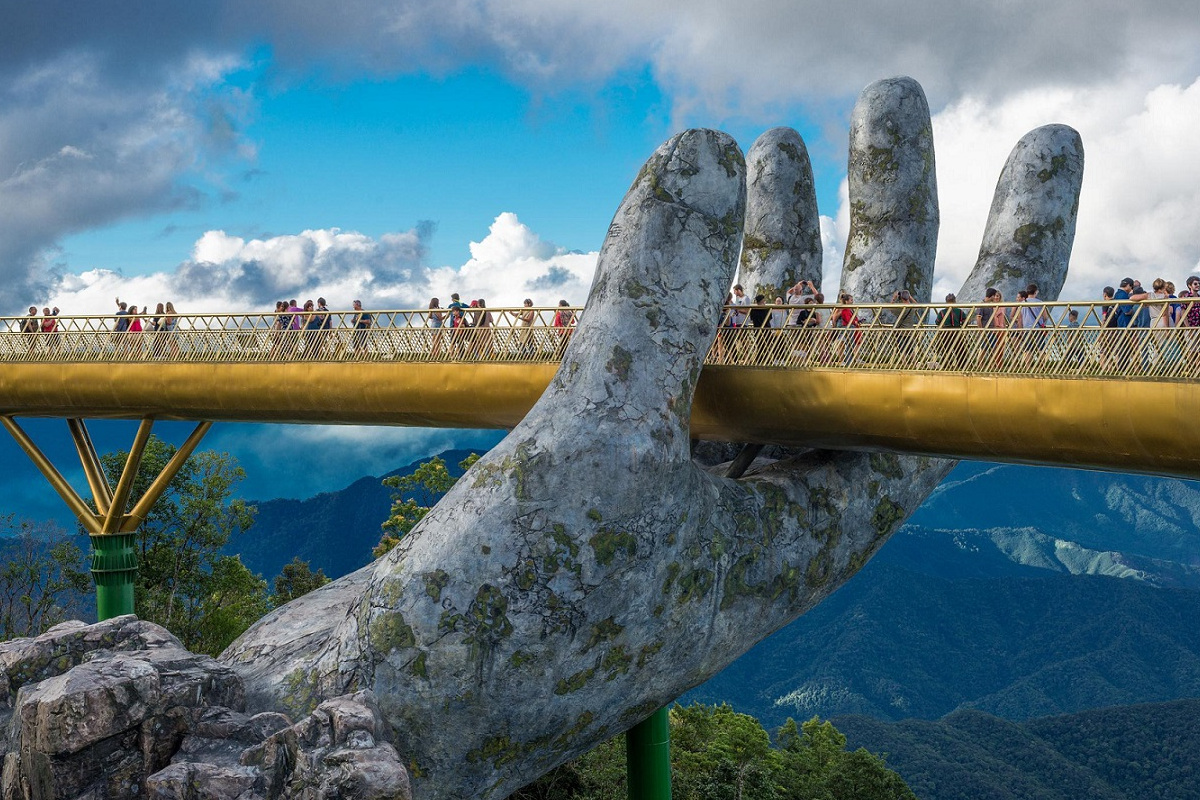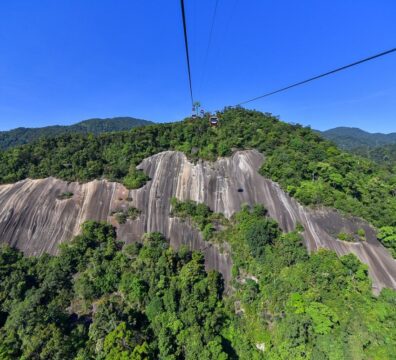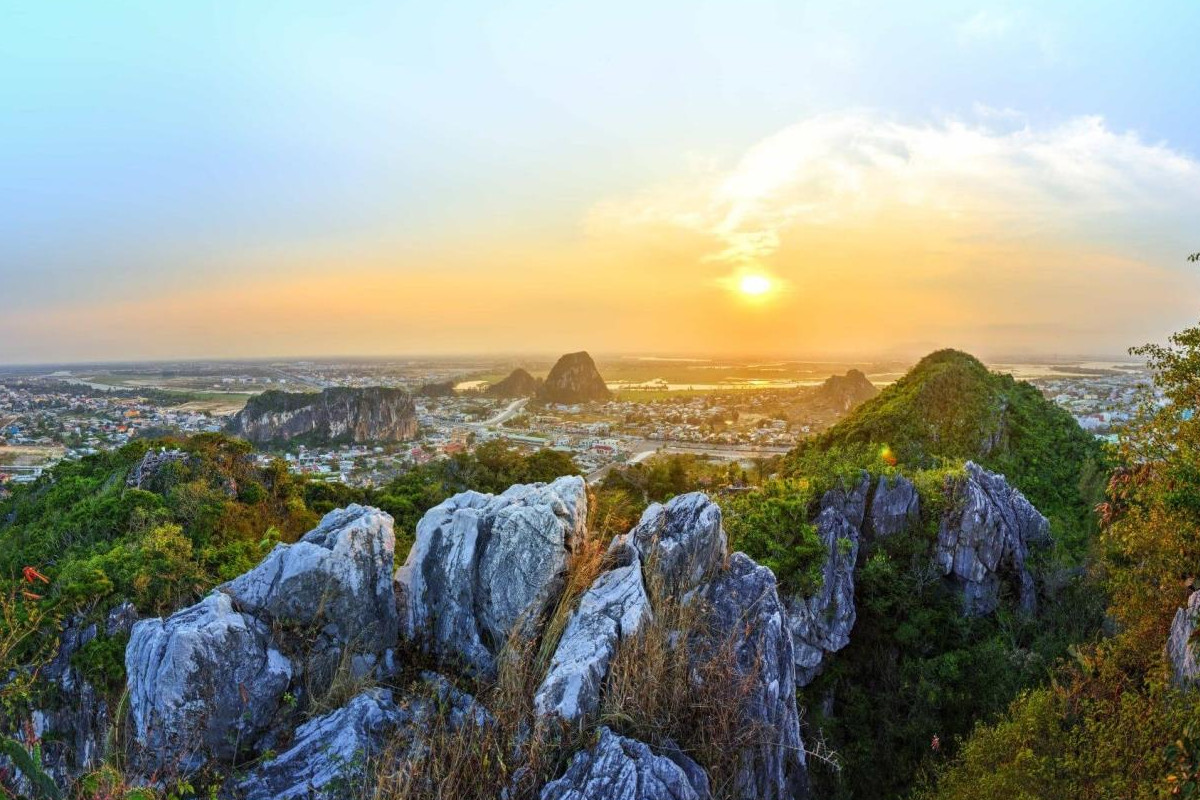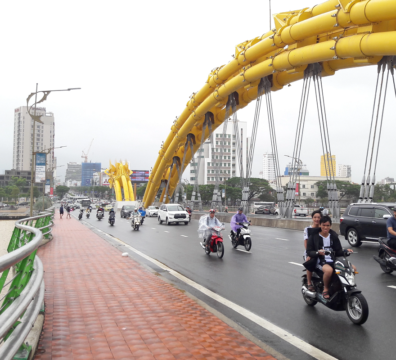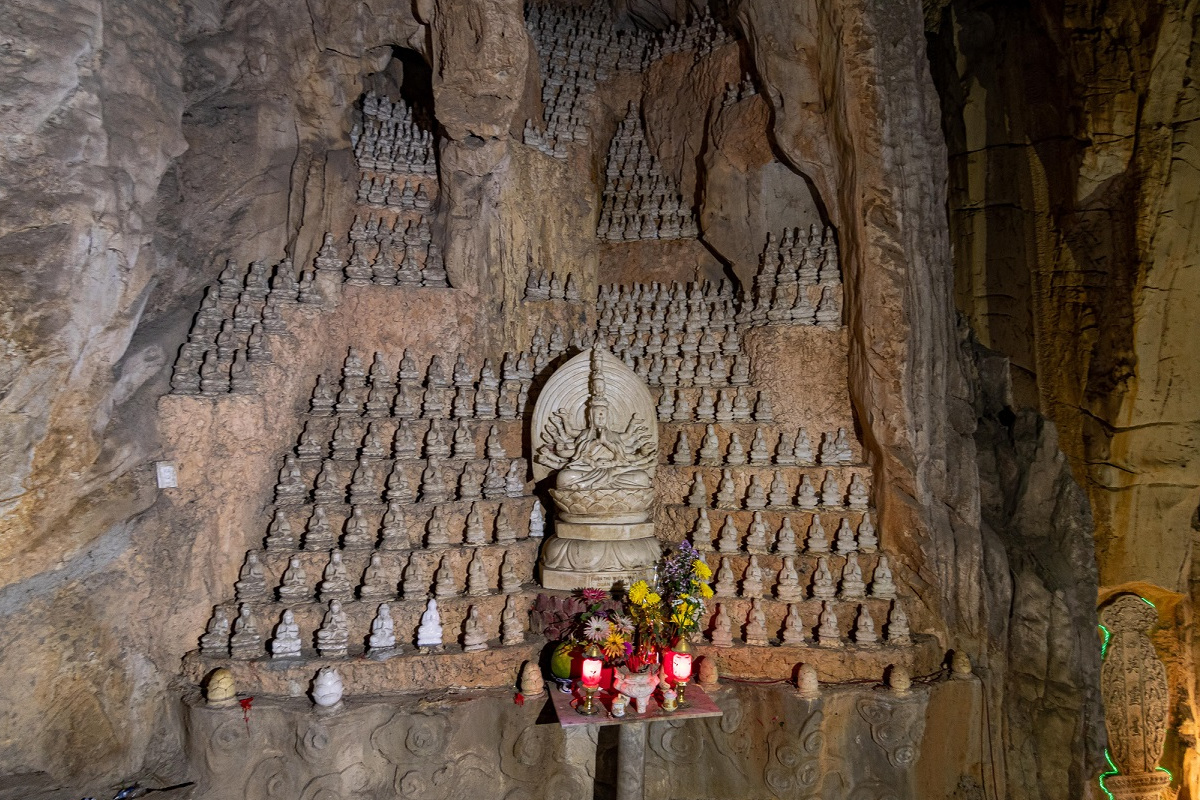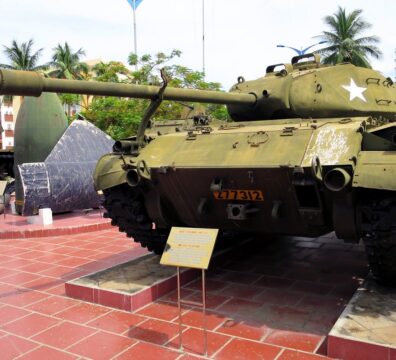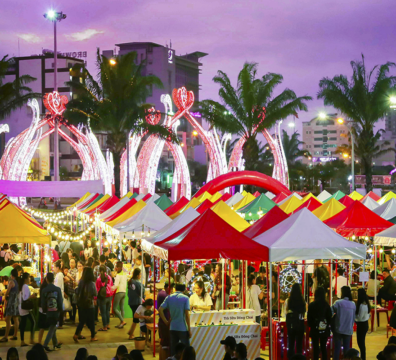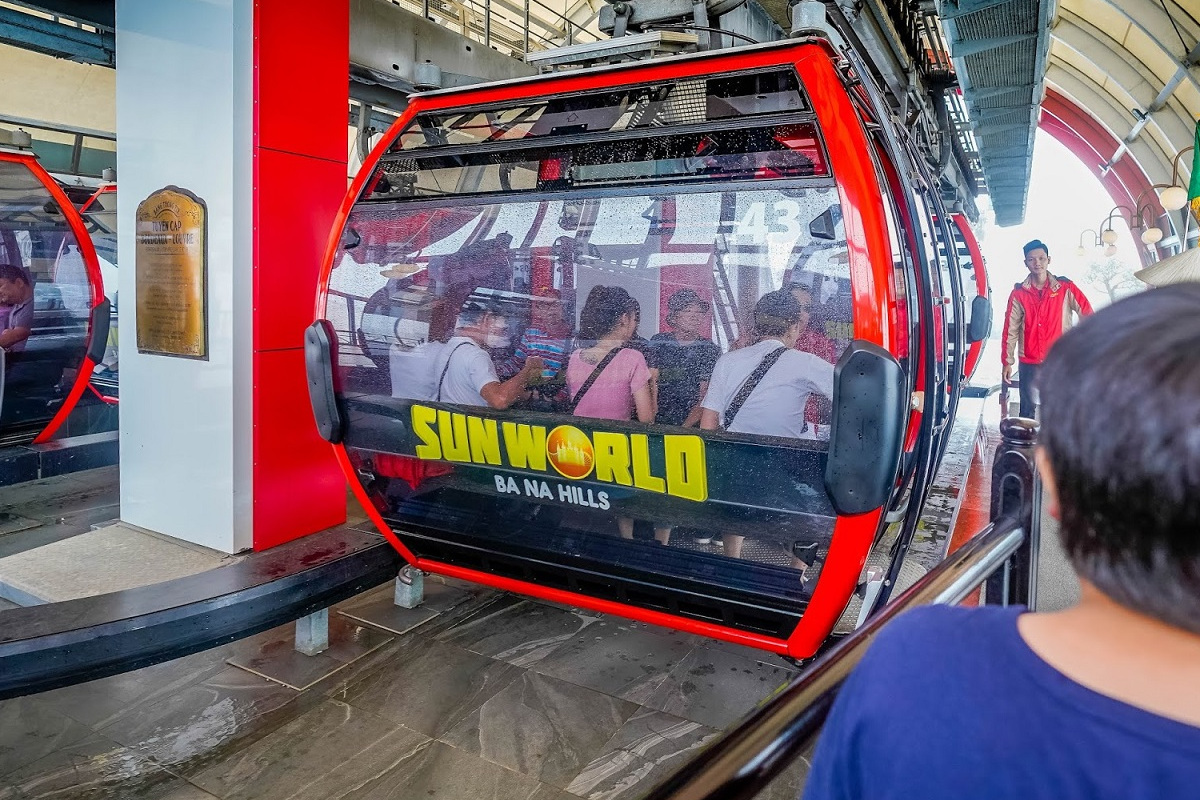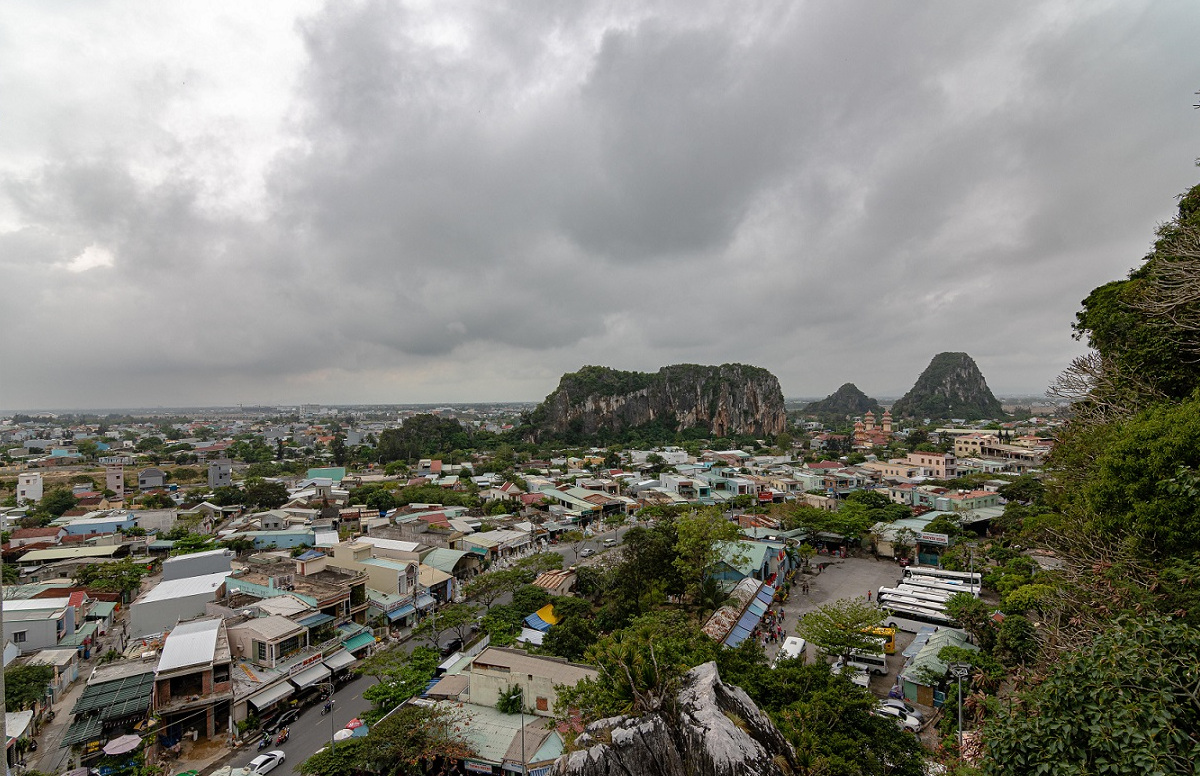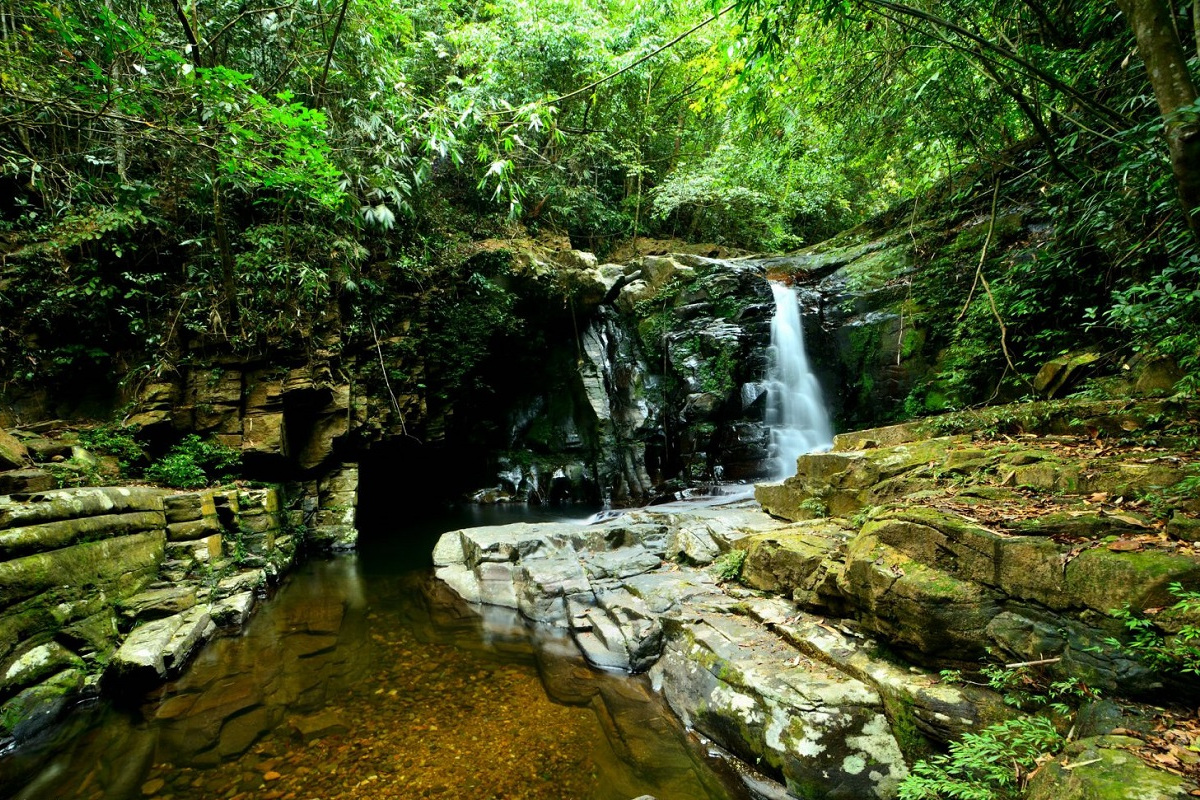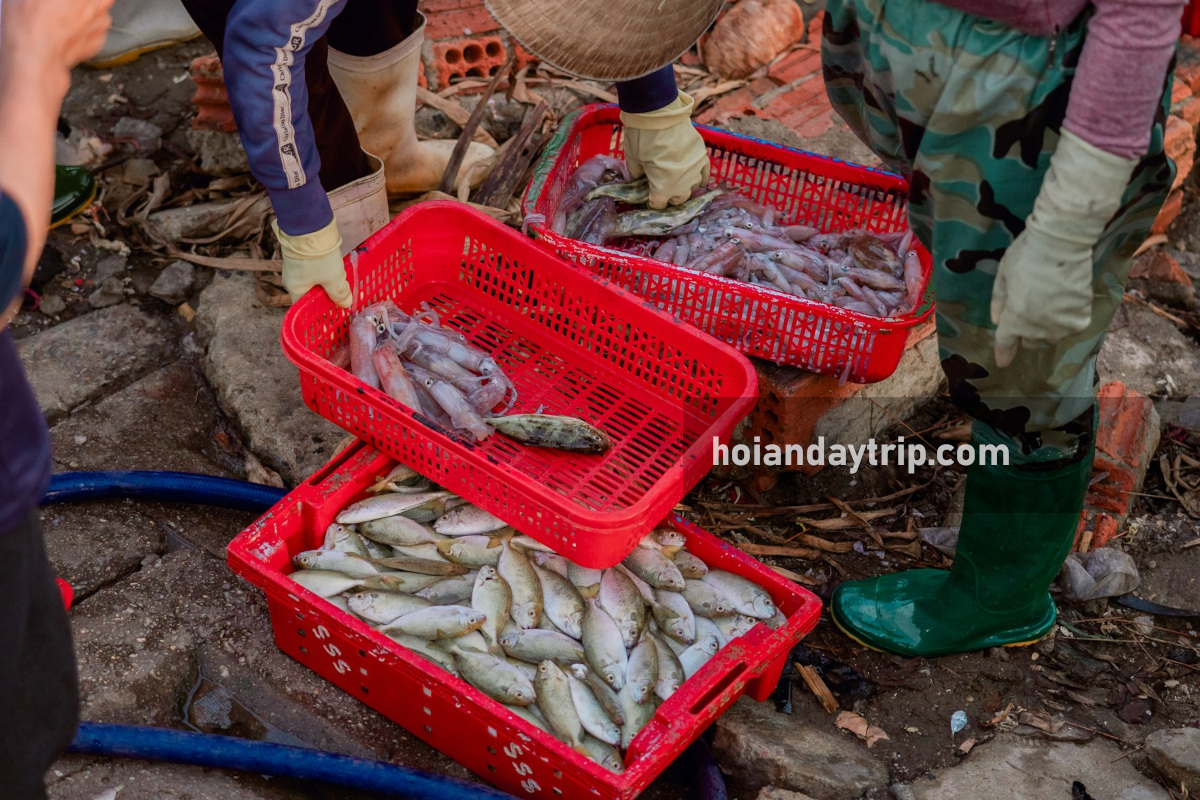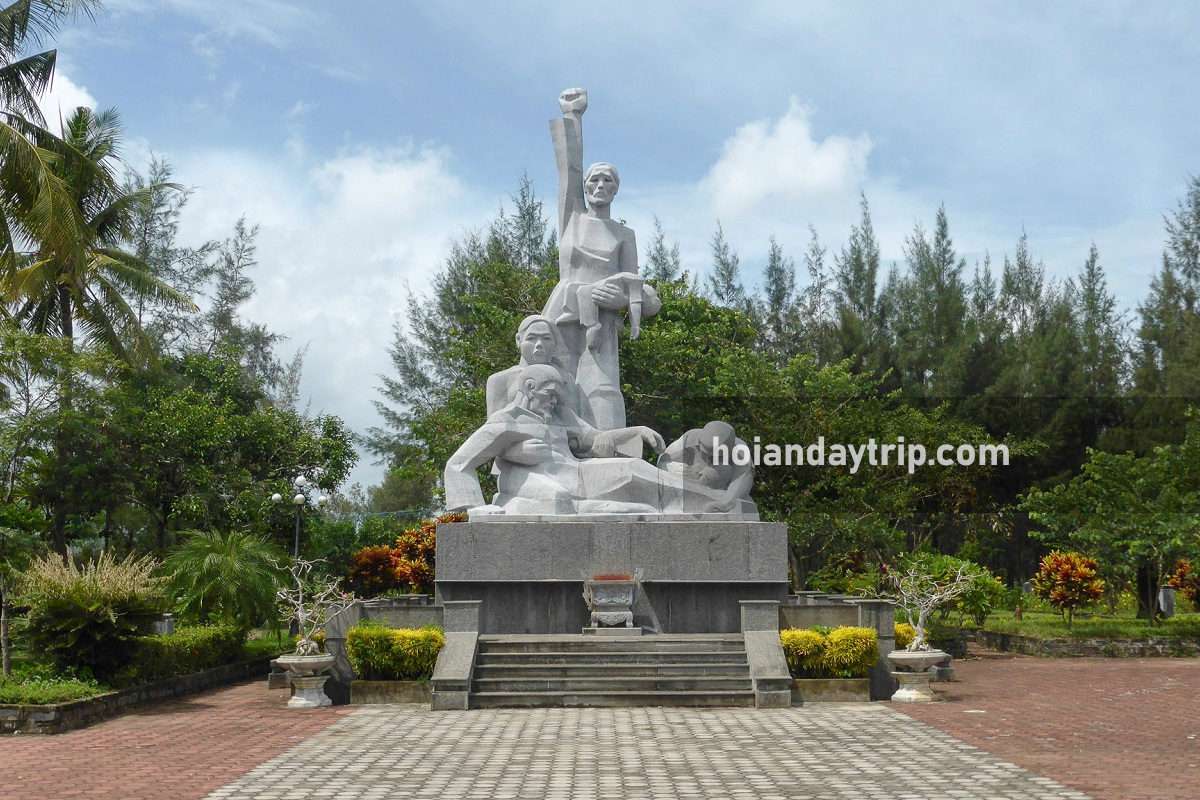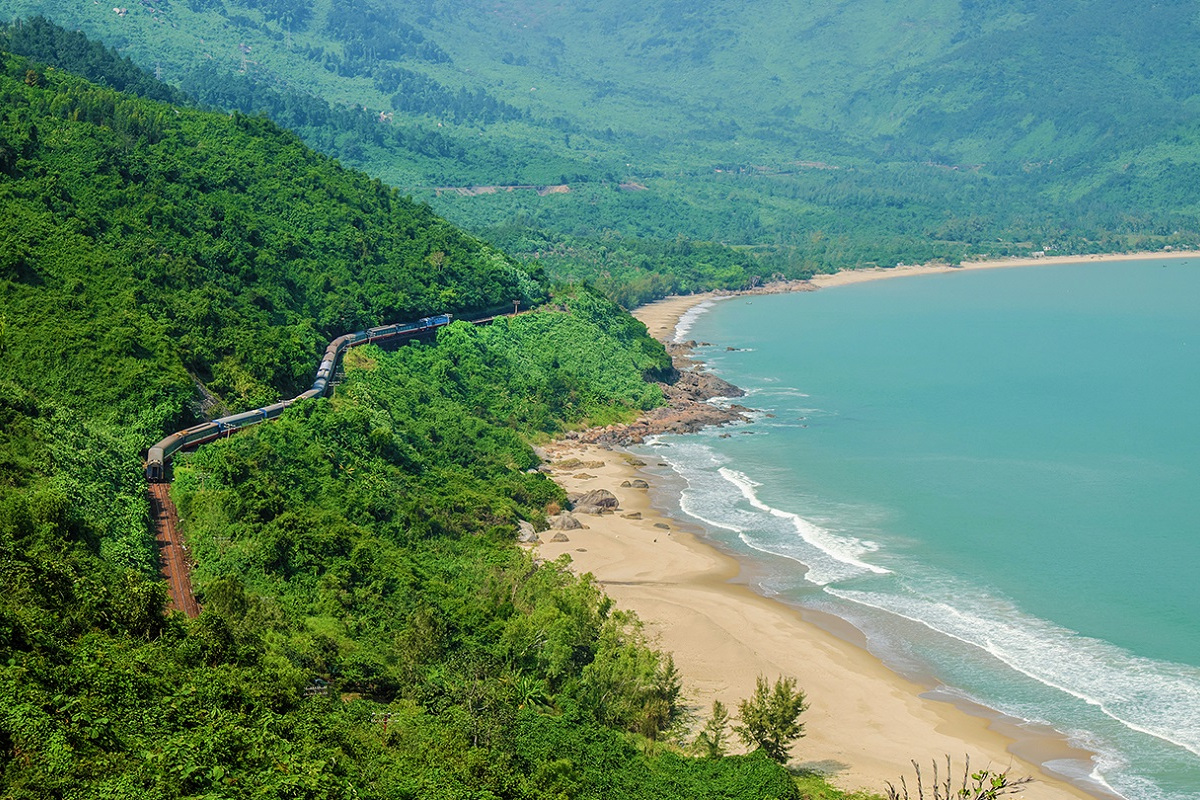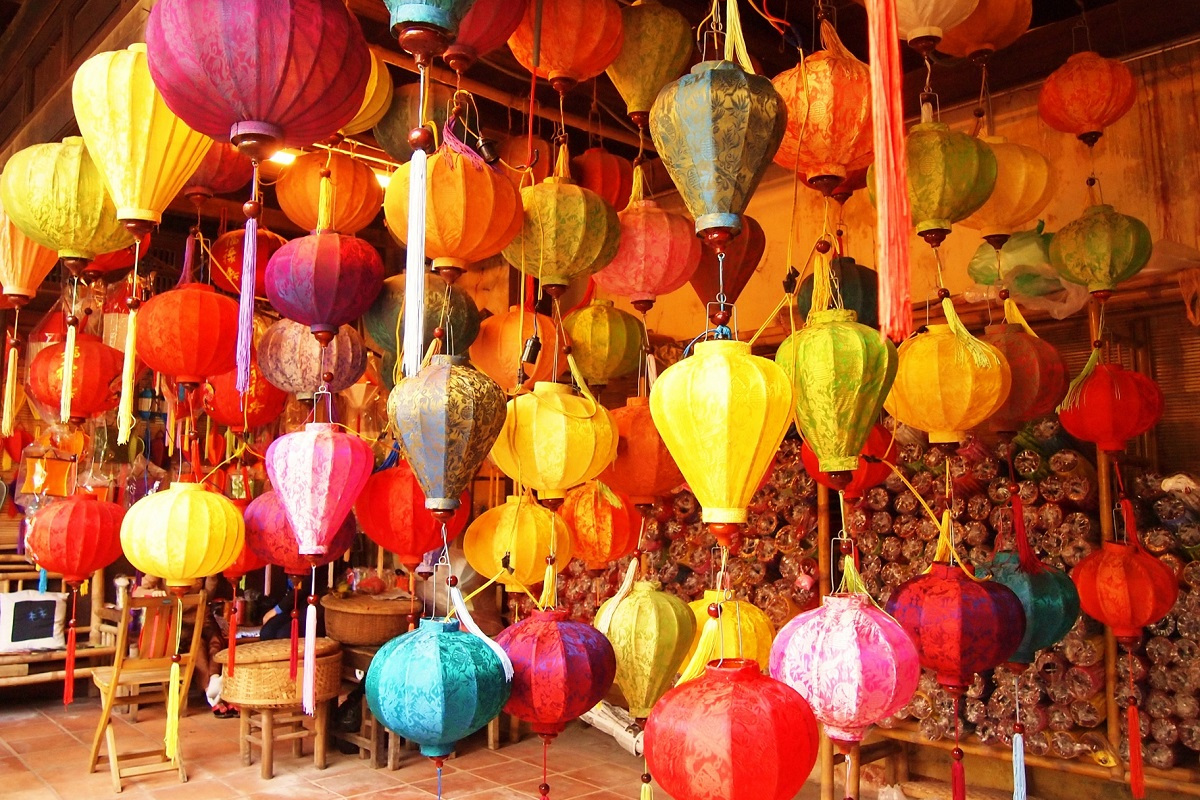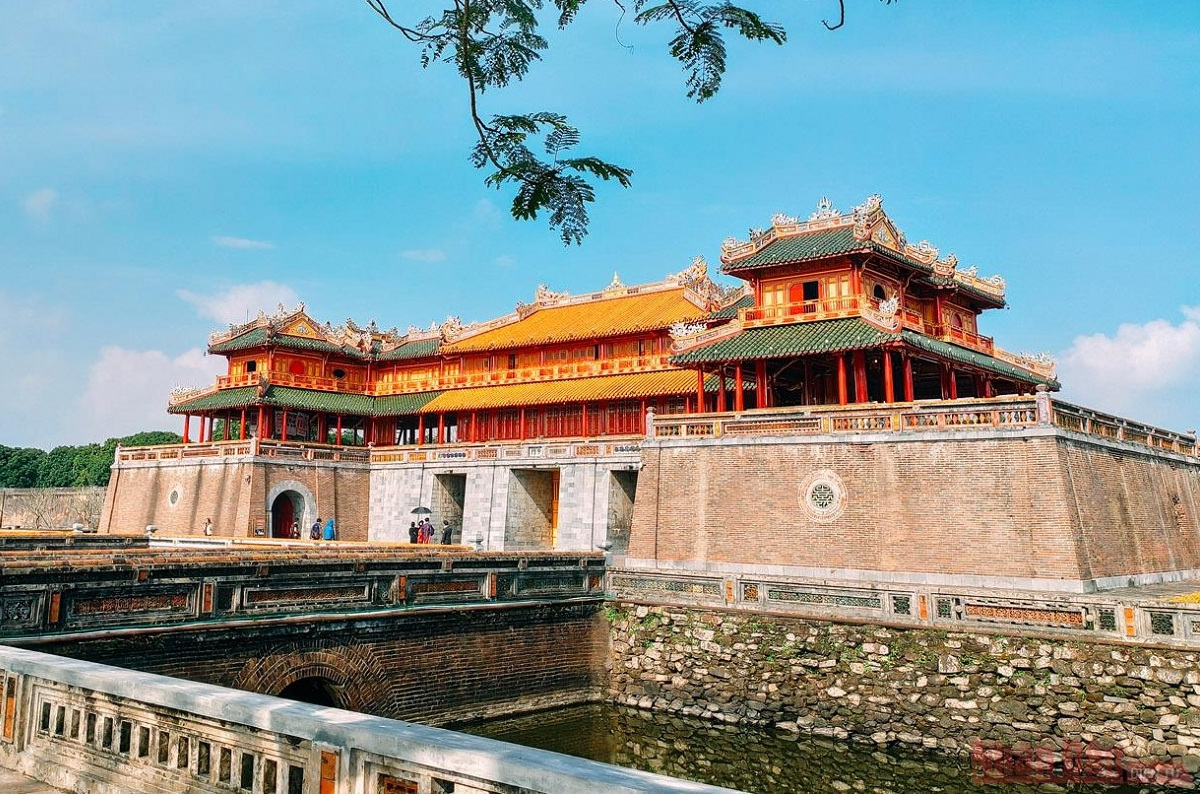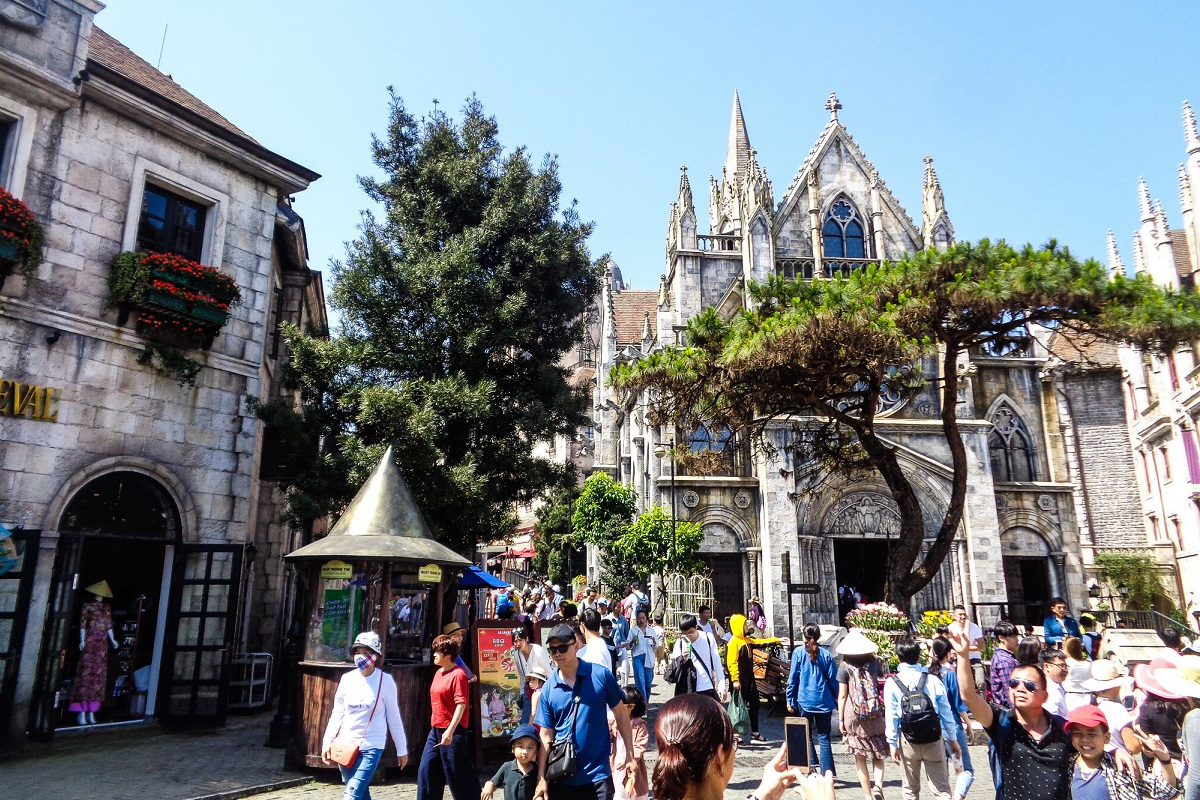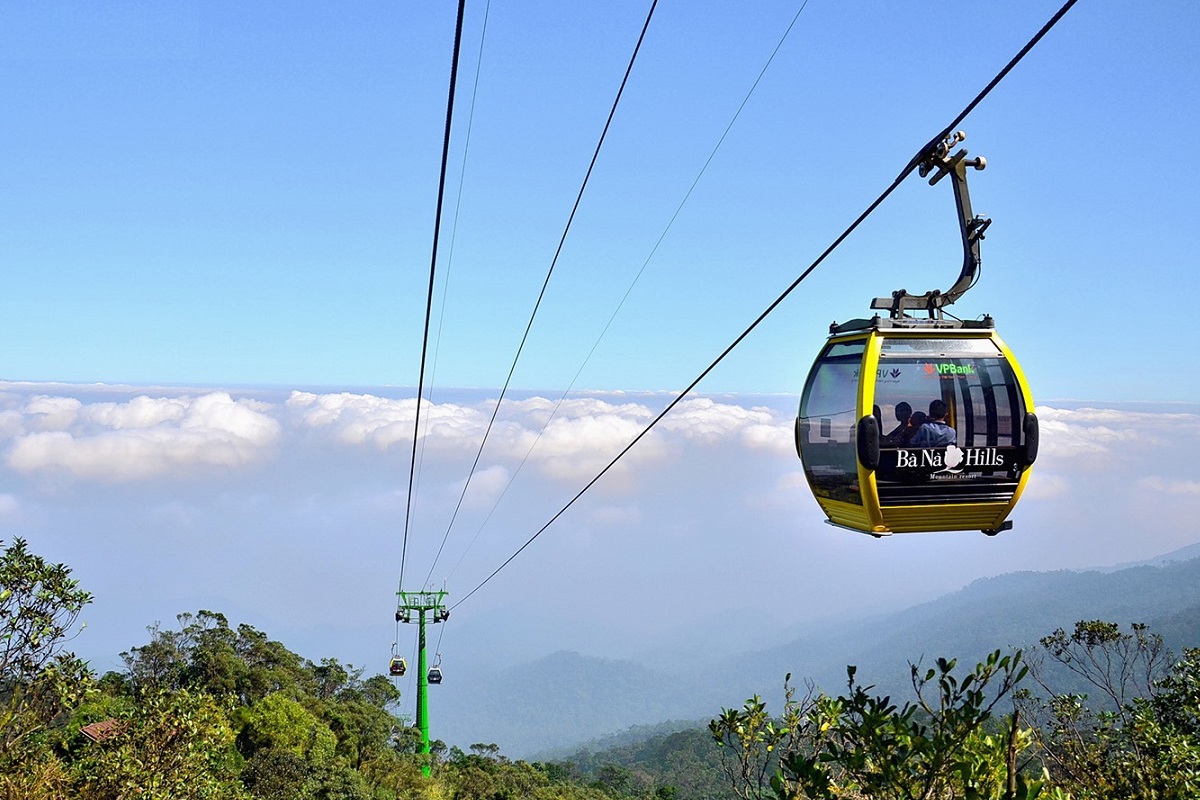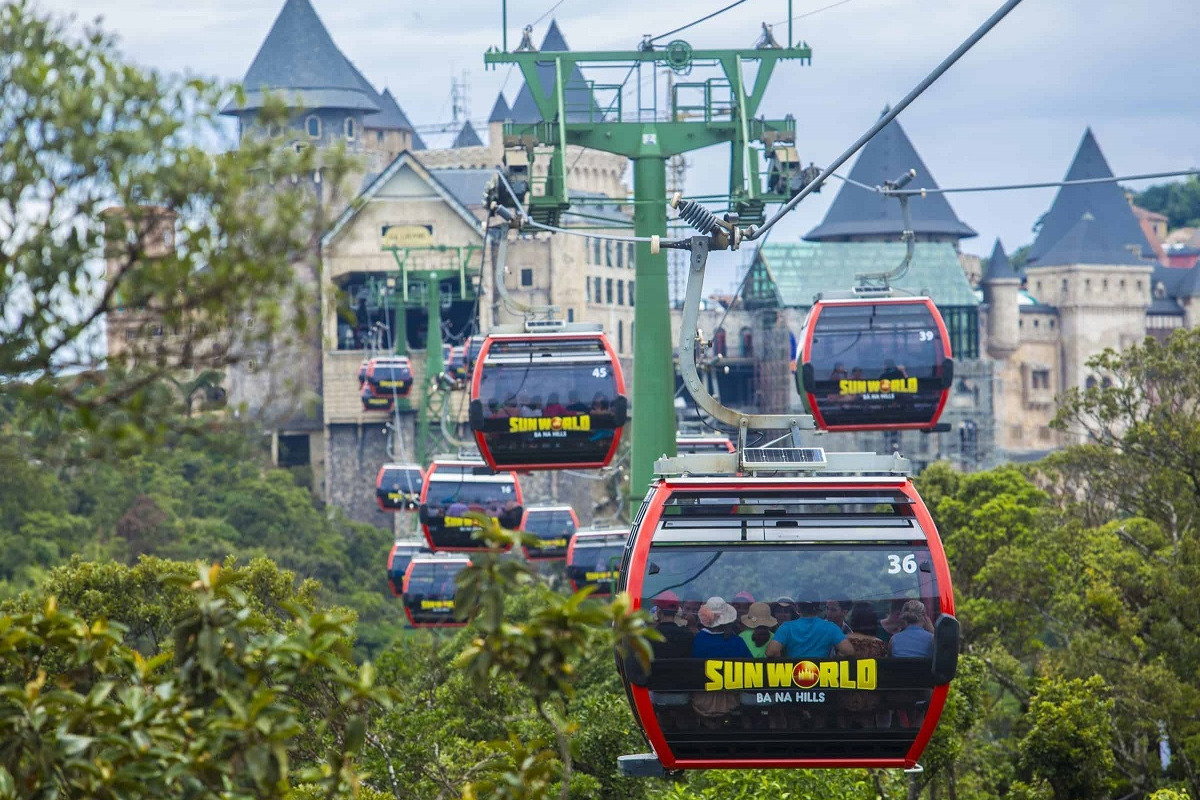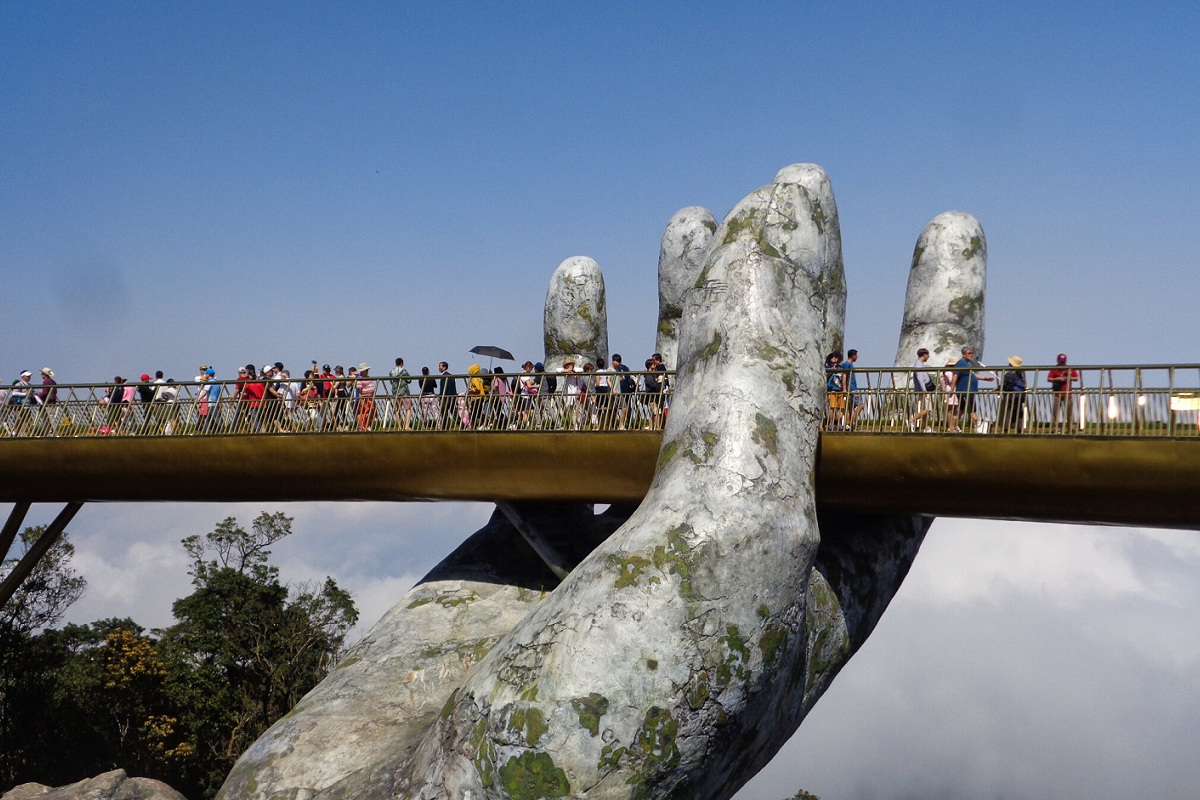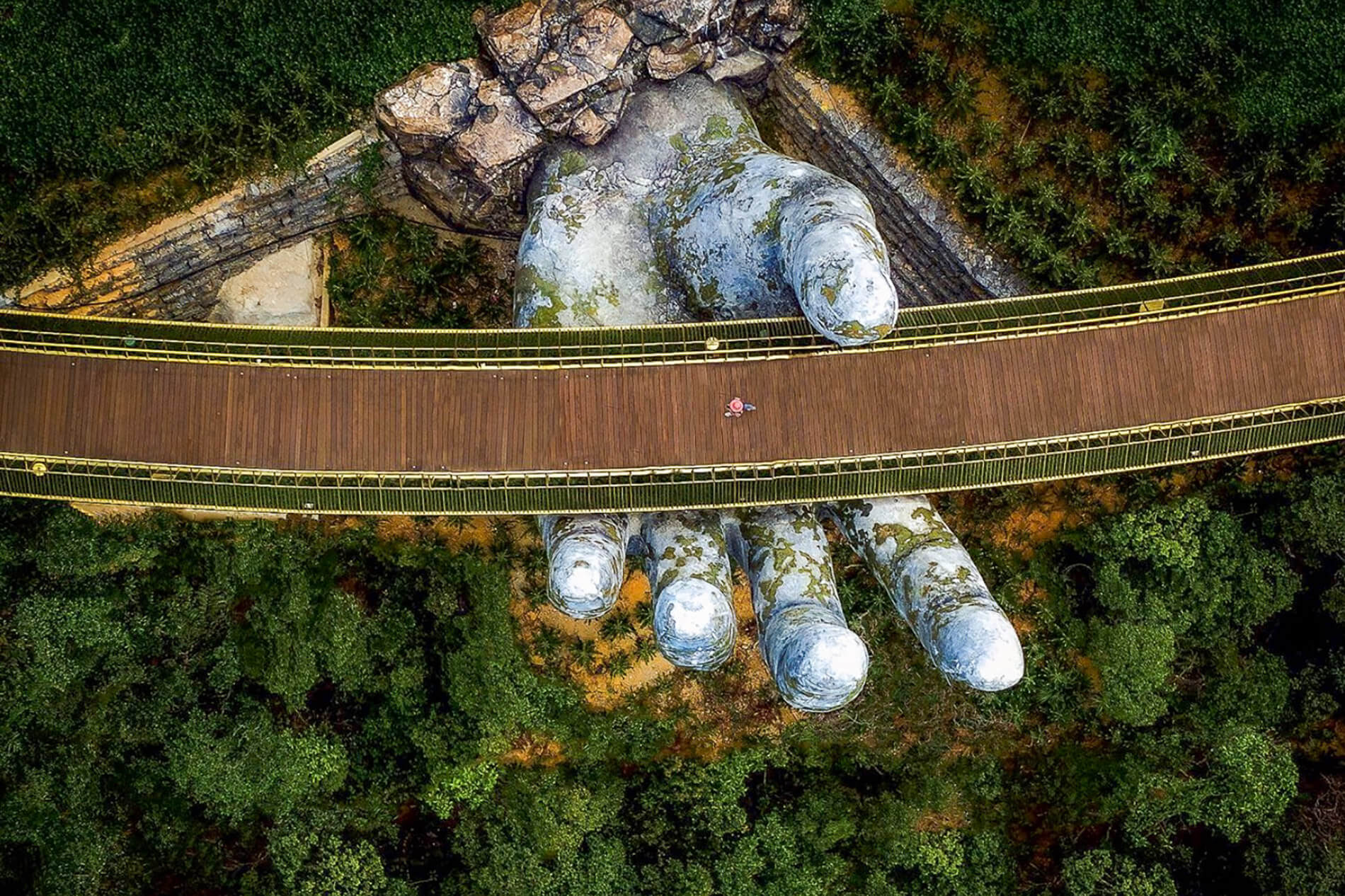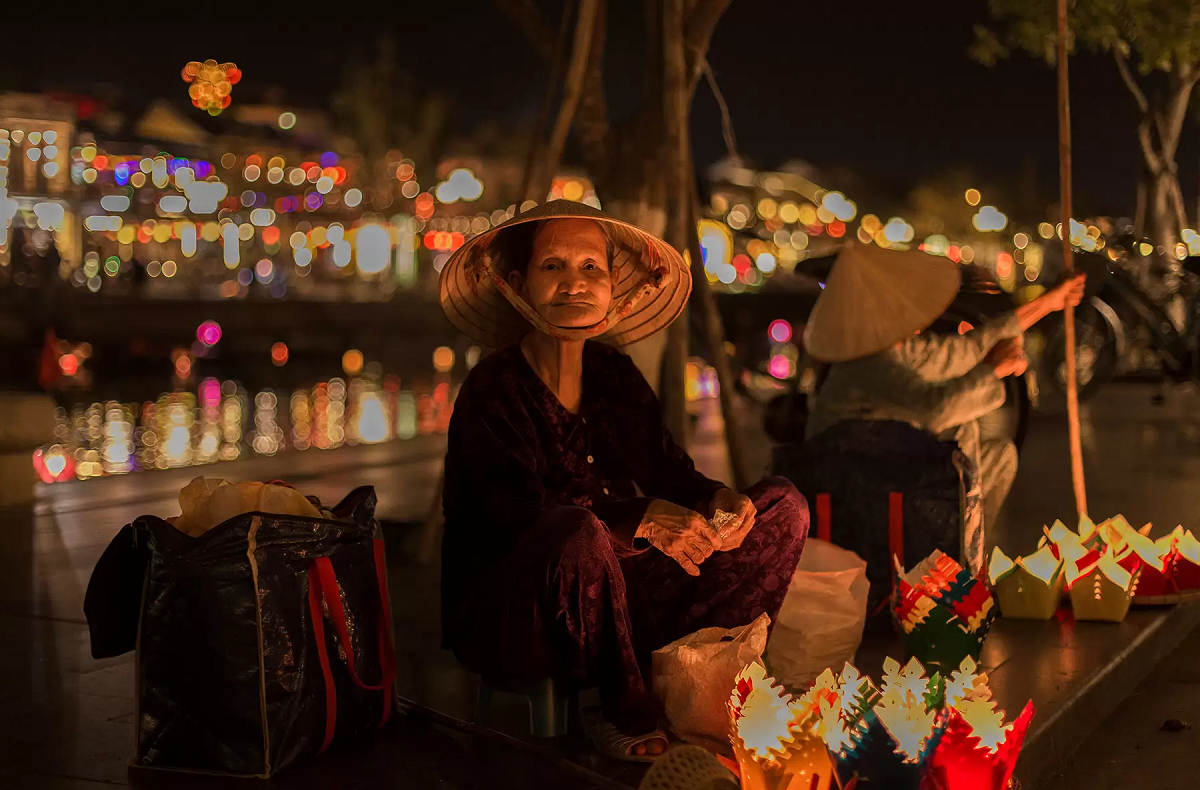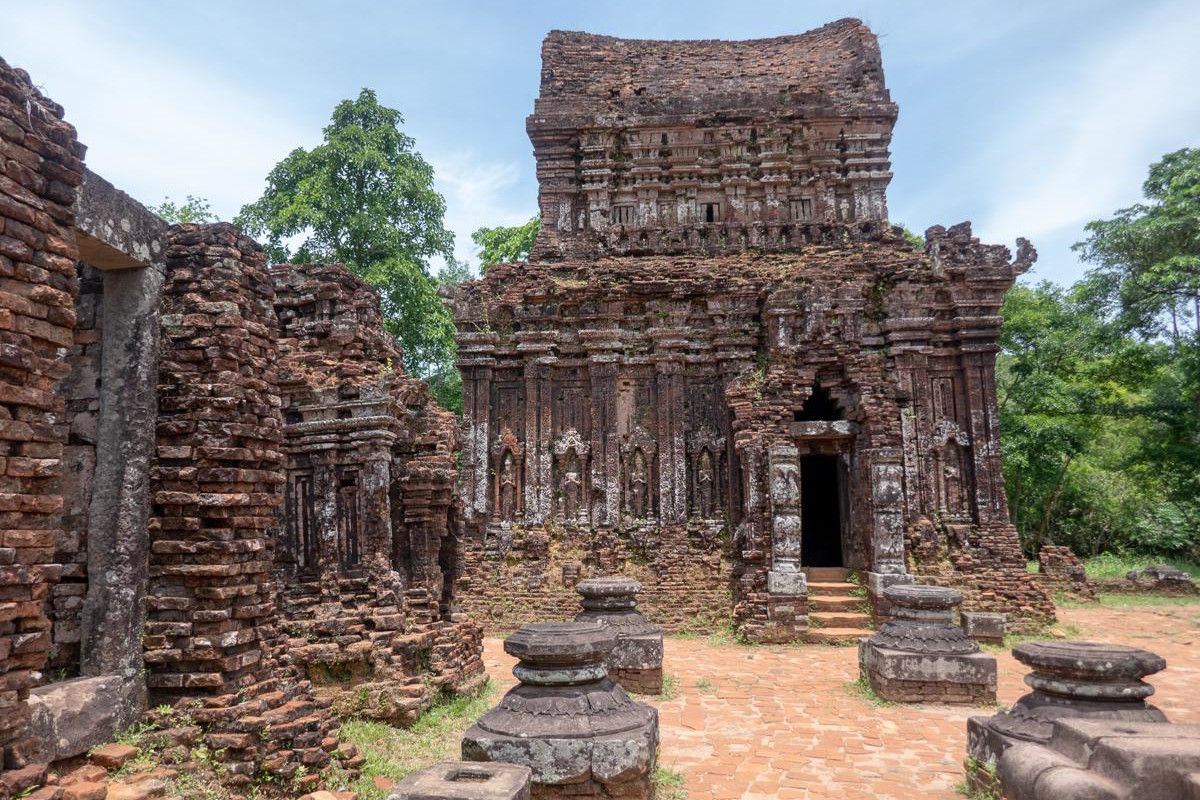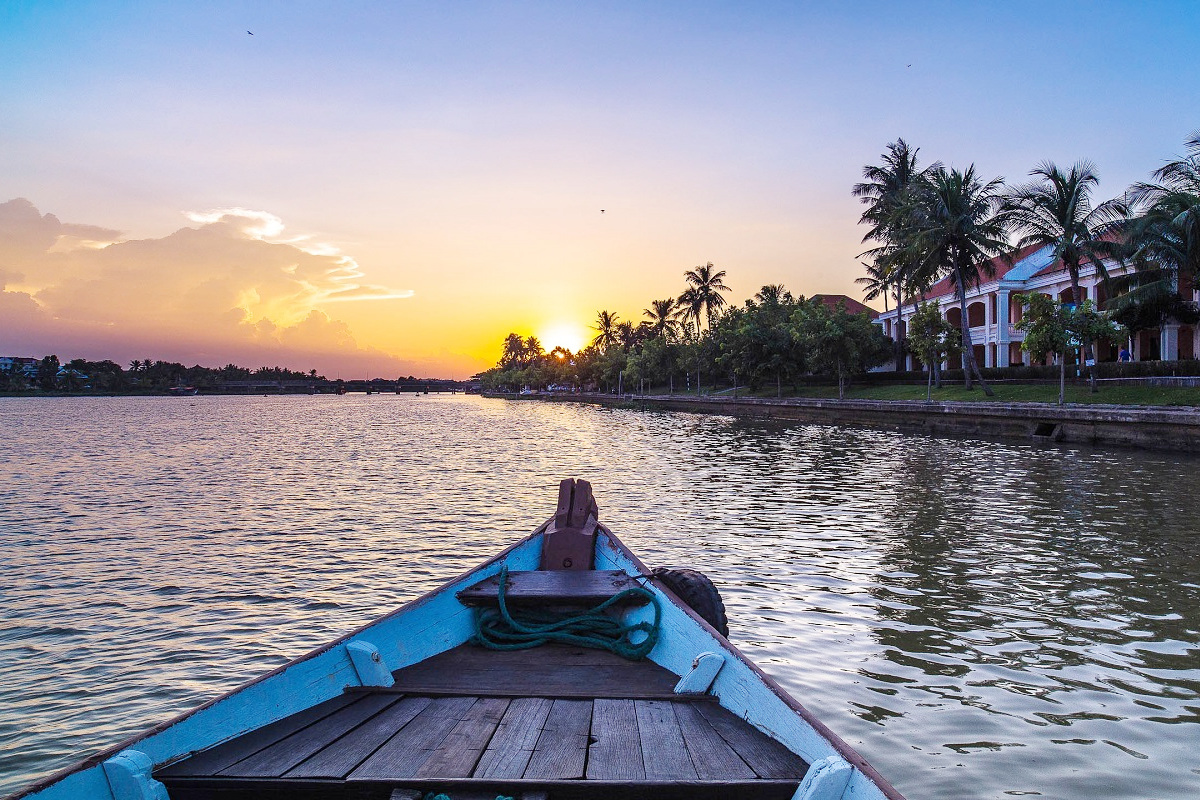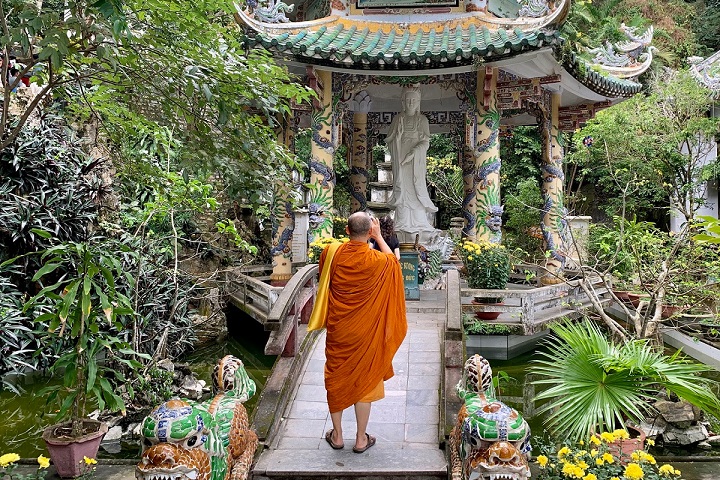Cable car is one of the first ideas travelers think about Ba Na Hills, a Da Nang’s top attraction. It helps to shorten the time to get to the hills from lower plains, improve visitor safety and reduce air pollution (as replacing car transfer). During the ride, passengers enjoy viewing pristine forests, wild streams, white-water falls, impressive outcrops below and weather phenomenons. The experience can’t be found anywhere in the region and yes, becomes a signature for the hill station. Meaning that whenever people talk about the hills, they talk about its cable car. In the end of any rides, travelers have the chance to have fun with many kinds of entertainments and see different sights. This article aims to provide you things that need to know about before begin your adventure with Ba Na Hills cable car.
See also:
- Ba Na Hills Travel Guide
- Golden Bridge Da Nang – Travel Guide
- Ba Na Hills Weather
- Ba Na Hills Accommodation
- How to get to Ba Na Hills from Da Nang
- Hoi An to Ba Na Hills
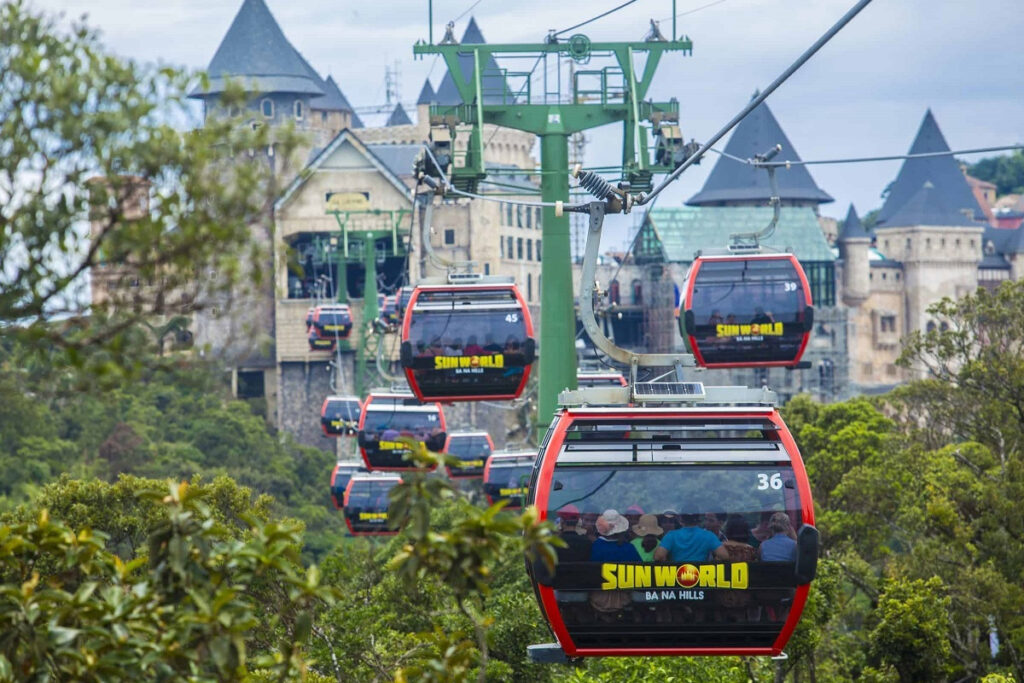
Table of content
- 1 Quick Introduction of Ba Na Hills Cable Car
- 2 Ba Na Hills Cable Car Lines
- 3 Ba Na Hills Cable Car Stations
- 4 Ba Na Hills Cable Car Schedule
- 5 Ba Na Hills Cable Car Tickets
- 6 Experience during Ba Na Hills Cable Car Ride
- 7 Cabin of Ba Na Hills Cable Car – A Review
- 8 Changes During Ba Na Hills Cable Car Ride
- 9 The Best Time to Get Ba Na Hills Cable Car
- 10 Why Build Cable Car to Ba Na Hills?
- 11 Ba Na Hills Cable Car – Lost and Found
- 12 Brothers and Sisters of Ba Na Hills Cable Car
- 13 Ba Na Hills Cable Cars Map
- 14 Related Posts
- 15 Non Nuoc Beach: The Famous Beach of Da Nang
- 16 How to Get from Da Nang to My Son Sanctuary
- 17 Bach Ma National Park: Hiking, Trekking in Da Nang and Hoi An
- 18 Am Phu Cave (Hell Cave) – Things to Do in Da Nang
- 19 Asia Park and Sun Wheel in Da Nang (Sun World Da Nang Wonders)
- 20 How to Get to Golden Bridge from Da Nang
- 21 Da Nang Food Specialties: What to Eat in Da Nang
- 22 How to Visit Golden Bridge Vietnam
- 23 Da Nang Shore Excursions: Guided Tours From Tien Sa Port
- 24 Han Market (Cho Han): Where to Shop in Da Nang?
- 25 Da Nang Cathedral (Da Nang Pink Church)
- 26 Things to Do in Ba Na Hills Besides Golden Bridge
- 27 Da Nang Half Day Tours
- 28 Da Nang Private Car and Driver
- 29 Da Nang and Hoi An Itinerary for Visitors Staying Overnight in Hoi An
- 30 Da Nang Things to Do: Guide to What to Do in Da Nang Vietnam
- 31 Da Nang Best Things to Do and Reasons
- 32 How to Get From Hoi An to Da Nang
- 33 Hoi An or Da Nang: Which is Better for First Time Visitor?
- 34 My Son Sanctuary Tour
- 35 Da Nang Best Area to Stay: Guide to Where to Stay in Da Nang
- 36 Da Nang Cave Tour: Best Underground Activities in Da Nang
- 37 Da Nang Best Time to Visit: Guide to Best Weather in Da Nang
- 38 Da Nang Weather by Month: Guide to Monthly Weather in Da Nang
- 39 What to Do in Da Nang At Night
- 40 Lang Co Vietnam Travel Guide
- 41 What to Do in Da Nang for 3 Days
- 42 My Khe Beach: A Complete Guide to Da Nang’s Best Beach
- 43 Da Nang Day Trips: Guide to Best Day Tours From Da Nang
- 44 Museums in Da Nang
- 45 Linh Ung Pagoda: Trio of Da Nang’s Holiest Mountain Temples
- 46 Da Nang Night Market: A Thing To Do in Da Nang at Night
- 47 Guide to Son Tra Mountain (Monkey Mountain) in Da Nang, Vietnam
- 48 Ba Na Hills Tour
- 49 Da Nang Cable Car
- 50 How to Get from Da Nang Airport to Hoi An
- 51 Da Nang to Hoi An: Best Da Nang Airport Transfer and More
- 52 Hai Van Pass Da Nang: Map, Route, Weather, History, Tour
- 53 Da Nang Attractions Guide: What to See in Da Nang Vietnam?
- 54 Guide to Lady Buddha (Goddess of Mercy) in Monkey Mountain, Da Nang
- 55 My Son Sanctuary Travel Guide
- 56 Da Nang Museum of Cham Sculpture
- 57 Dragon Bridge Da Nang: The Fire-Breathing Da Nang Bridge
- 58 Ba Na Hills Travel Guide: A First Timer’s Complete Guide
- 59 Golden Bridge Da Nang: A Guide to The Iconic Da Nang Bridge
- 60 Da Nang Bridge: A Guide to Famous Bridges in Da Nang
- 61 Ba Na Hills Cable Car: World Record, Cost, Reschedule, Map
- 62 Da Nang Mountain Temple: Marble Mountain’s Pagodas, More
- 63 Da Nang Caves: Underground World of the Marble Mountains
- 64 The Marble Mountains: Guide to Da Nang’s Iconic Mountain
- 65 Featured Tours and Experiences
- 65.0.1 Bach Ma National Park Tour from Hue
- 65.0.2 Bach Ma National Park Tour from Da Nang/Hoi An
- 65.0.3 Hoi An Sunrise Fish Market Tour
- 65.0.4 My Lai Massacre Tour
- 65.0.5 Golden Bridge/Ba Na Hills & Hoi An Tour
- 65.0.6 Hoi An Instagram Tour
- 65.0.7 Ky Anh Tunnel & Tam Thanh Mural Village Tour
- 65.0.8 Da Nang to Hue Motorbike Tour with Hai Van Pass & Easy Rider (1 Way)
- 65.0.9 Hue to Da Nang Motorbike Tour with Hai Van Pass & Easy Ride (1 Way)
- 65.0.10 Hue to Hoi An Motorbike Tour with Hai Van Pass & Easy Rider (1 Way)
- 65.0.11 Hoi An to Hue Motorbike Tour with Hai Van Pass & Easy Rider (1 Way)
- 65.0.12 Tra Que Vegetable Village Tour with Cooking Class
- 65.0.13 Ba Na Hills Half Day Tour from Hoi An
- 65.0.14 Marble Mountain & Hoi An Day Tour from Da Nang Port
- 65.0.15 Hue Day Tour from Chan May Port with Lunch
- 65.0.16 Marble Mountain & Hoi An Tour from Chan May Port
- 65.0.17 Ba Na Hills/Golden Bridge Tour from Da Nang Port
- 65.0.18 Ba Na Hills/Golden Bridge Tour from Chan May Port
- 65.0.19 Golden Bridge Private Tour with Ba Na Hills & Lunch
- 65.0.20 Ba Na Hills Afternoon Tour with Golden Hands Bridge
- 65.0.21 Ba Na Hills Private Tour with Golden Hands Bridge
- 65.0.22 Ba Na Hills Half Day Tour with Golden Bridge
- 65.0.23 Ba Na Hills Early Morning Tour to Beat the Crowds
- 65.0.24 Golden Bridge and Ba Na Hills Night Tour
- 65.0.25 Golden Hands Bridge Tour In Sunrise or Sunset (1/2 Day)
- 65.0.26 Cam Kim Island Bicycle Tour From Hoi An
- 65.0.27 Cham Island Tour From Hoi An (Group Tour)
- 65.0.28 Cham Island Tour From Da Nang (Group Tour)
- 65.0.29 Hoi An Vegetarian Food Tour
- 65.0.30 Hoi An Evening Walking Food Tour with Local Foodie
- 65.0.31 Private Hoi An Basket Boat Tour (Shuttle Bus, Bicycle, Bike)
- 65.0.32 Half-day Am Phu Cave Tour (Private)
- 65.0.33 Hoi An Countryside Tour by Electric Car or Bike
- 65.0.34 Da Nang Tour Package From Singapore
- 65.0.35 Hoi An Evening Tour From Da Nang with Lantern Boat Ride
- 65.0.36 Hoi An Walking Food Tour Through Laneways
- 65.0.37 My Son Sanctuary and Hoi An Old Town Tour
- 65.0.38 My Son Day Trip From Hoi An including Marble Mountains and Basket Boat
- 65.0.39 Half Day Hoi An City Tour With River Cruise
- 65.0.40 Son Tra Peninsula Tour with Marble Mountains (Private/Small Group)
- 65.0.41 Hue Day Trip From Hoi An with Hai Van Pass, River Cruise & Lunch
- 65.0.42 Hoi An Ancient Town and Countryside Tour (Bests of Hoi An Tour)
- 65.0.43 Hoi An Tour From Da Nang Airport (Private, Optional Lunch)
- 65.0.44 Hoi An Day Trip From Da Nang (Marble Mountains, Basket Boat, Old Town)
- 65.0.45 Da Nang City Tour From Airport (Private, Optional Lunch)
- 65.0.46 Hoi An City Tour with Lantern Class, Lantern Boat, Night Market & Local Food Sampling
- 65.0.47 Marble Mountains, Basket Boat Ride & Hoi An Old Town Walking Tour
- 65.0.48 Marble Mountains & Golden Bridge/Ba Na Hills Day Tour
- 65.0.49 Marble Mountains & Monkey Mountain Tour (Half-day, Private)
- 65.0.50 Private Golden Bridge Sunrise Tour (Half-day, Optional Lunch)
Quick Introduction of Ba Na Hills Cable Car
Constructed by the Sun Group and Austrian engineers, the network of cable cars is an inseparable part of the famed Ba Na Hills. The first was built in 2009 and since then, there are 3 others added. Because of being responsible for transporting people to the top of Da Nang’s summit, the height and length of some lines in this network hold world records. Today, cable cars are the only choice to reach the mountain resort and its attractions. At least one line construction is on-going and opened to tourists soon.
Ba Na Hills Cable Car Height
Ba Na Hills cable car carries travelers to a height of 1,485 meters above the sea level, Nui Chua summit.
Ba Na Hills Cable Car Length
The largest length of a line of Ba Na Hills cable car is 5,801 meters.
Ba Na Hills Cable Car Lines
Now, Ba Na Hills mountain resort has 5 cable car lines and soon more with on-going constructions. Not only 2 rides to go up and down, here travelers have the chance to experience extra without charge, with a pair of transiting lines between major areas.
The Line 1&2
This is the first cable car line built in Ba Na Hills history. Launched in March 2009, it immediately holds 2 world records: the line of the largest elevation between its stations (over 1,290 meters) and the longest single-track line (5 km). The first is always special. Each of its 94 cabins is designed with a shape of bell cherry blossom, the emblem of the hill station. Number of passengers allowed is 8 persons maximum. While sitting in its cabin, it’s possible to view Toc Tien waterfall flowing down from a 700-meters-high cliff. If getting another cable car, travelers just can see a part or can’t see. Whichever ride up or down, Line 1 is the favourite of so many people and sometimes forgotten because of newer lines. Line 2 is from the end of Line 1 to the Ba Na Hills French Village. See information of their stations below here.
The Line 3
Because of stunning experience and two world records, the first cable line became popular to visitors quickly and so that, overloaded. To make the queues shorter, Line 3 was constructed in 2013. Up to day, this second-built line is still only non-stop, from foot of the hills to the French village. With an addition of 80 meters, it replaces its older brother’s place, to be the world’s largest elevation between two terminals. Three other records of it are the longest unpatched wire (11.587 meters), the longest one-wire sling (5.777 meters) and the heaviest cable roll (approximately 142 tonnes). This is also to celebrate the 38th commemoration of the Vietnam war stopping in Da Nang.
86 cabins are designed to be able to transport 3,000 passengers per hour and each one contains 10 people maximum. It takes 17 minutes to complete a ride in Line 3. Thanks to being without transit, lots of travelers choose it, to avoid joining the queue twice in high seasons. However, the guide in organized tours also recommends his visitors to return to the city by this line, making its upper station (L’Indochine) often packed.
The Line 4&5
Opened from 2017, Line 4 and 5 are the youngest Ba Na Hills cable car, aiming to serve visitors the quickest ride to awesome attractions as possible. Line 4 starts from a station by open landscaped spaces inspired from Hoi An town and ends in somewhere near the Golden bridge. So, it becomes the best choice for those who would like to visit that world-famous bridge first. Thanks to being modernest, cabins of it contain most passengers. For a big group, that’s so great to sit beside and enjoy everything together. Line 5 gives a ride from flower gardens to the French village (same to Line 2). It’s free of charge and takes only a few minutes.
Which is the Best Line?
Ba Na Hills cable car lines are operated on a reschedule that may be changed daily. So, the best line is what is available to get on, rather than a personal favorite. The best itinerary is that of selecting one line to reach up the mountain and another to go down. But if most lines are run at the same time, which one is nicest to begin the first ride?
Above all, the selection depends on which place you would like to see first: French village, Golden bridge, the Buddha or theme park? If you prefer the Golden Bridge, a must-visit for Instagrammers, you should get the Line 4. There is just a short walk from its arrival station to that place. If it does not open yet, choose Line 1 (from Toc Tien station). If like to come to a buffet lunch restaurant or take a ride on Alpine Coaster first, Line 3 is your choice. For the views from the cabin, Line 3 and Line 4 allow to see the most spectacular sceneries.

Ba Na Hills Cable Car Stations
There are 10 stations at the moment, 3 in the foot of the mountain and 7 in the upper parts. In addition, 3 of 10 serve as a transit place for the rides between two main areas: the Golden Bridge and French Village. Name of stations links to local history and French culture.
Toc Tien and Ba Na Stations (Line 1)
Toc Tien and Ba Na are two cable car terminals of Line 1, the first in Ba Na Hills. Toc Tien (for departures) is named the same as a breath-taking white water fall nearby. It means “the hair of fairy lady”. To get to it, visitors need to walk upstairs quite far from the ticket counters. Escalators are available but sometimes broken down because of high air humidity. After leaving the station for a few minutes, passengers can see that wonderful waterfall from the cabin. Browse centralvietnamguide.com/da-nang-waterfalls to know other pretty falls around the city.
The last station is Ba Na and it takes 15 minutes to get there. From Ba Na station, travelers can take a short walk to Debay station (to reach the French village). With the same distance, D’Amour station provides a funicular ride up to a place between Golden bridge and flower gardens. Before the presence of the mountain train, tourists access Linh Ung pagoda by a road and steps close by. Now, many people still choose to avoid the queue in stations during the high seasons. Some nice pictures can be taken en route, with cabins moving through clouds, above wooded mountains or colorful hydrangea flowers.
Debay and Morin Stations (Line 2)
Line 2 allows tourists to get to the French village after Line 1 finishes. To take a ride on its cabins, come to Ba Na station near the lower station of the funicular and downstairs from Linh Ung pagoda. During its 5-mins duration, passengers can view Vong Nguyen hill where old French villas still stand and Da Nang’s largest mountain roller coaster. The arrival station is Morin, name of a French businessman who built the first hotel in Ba Na Hills. He also owned many others around the country in the colonial time. After getting off the cabin, passengers need to walk upstairs for a while. From the main entrance of the station, a broad view over the French village is provided, popularly appearing in social media. Upper floors are home to the Morin restaurant where a la carte menu is served.
From Morin station, it’s convenient to get all parts of the whole area. Turn right, you can get Morin hotel, Starbuck, the Twelve zodiac signs, high viewpoints and Beer Plaza restaurant. Walking down all the steps and turning left, the entrance of Fantasy theme park is on the lowest terrace. Going straight, temples in the summit and the rest of the village can be accessed.
Suoi Mo and L’Indochine Stations (Line 3)
As the highest cable car station, Suoi Mo is where the cabins of Line 3 depart. Its name is taken from the nearby waterway, meaning “the Fairy stream”. The stream can be seen from the cabin at the beginning. It takes 17 minutes to arrive at the next (last) station, L’Indochine, name of the French colonial federation for Vietnam, Laos and Cambodia. During a ride of this non-stop line, passengers move above the untouched environments of Ba Na-Nui Chua nature reserve. To the further left, the highest peaks are in Bach Ma national park and much closer, on-going construction of a new line. After leaving the cabin in the upper station, travelers will walk upstairs or get escalators, and at the end of the passageway, that is the centre of French village. From there, all places are easily reached. In the late afternoon (high seasons), the line of waiters for the return ride is really long.
Hoi An and Marselle Stations (Line 4)
Because of being youngest, Hoi An station is the largest cable car terminal in Ba Na Hills. From ticket counters, travelers need to walk in the big Three-arched Gate first. Then, walk upstairs to the upper terrace and follow the signal boards. Generally, the station is to the left and on the way, Hoi An-inspired landscaped gardens provide much photo opportunties. To meet the cabins, once again, it’s needed to walk over steps and while being close by them, travelers can see a scene of Hoi An at night. Sit back and enjoy fantastic sceneries along the 15-mins ride, among the bests travelers can see. Giant outcrops are such spectacular below the cabin, featuring tree-free surfaces (like Australian Uluru).
The arrival is Marseille station. From there, insprirational Golden bridge is after a short walk to the right. In the Dome, live circuits and performances of dancers usually occur. The way leading to the station for reaching French village is just nearby (namely Bordeaux). If don’t take a cabin in Line 2 (or it doesn’t open), travelers have to return here to reach the village, another draw.
Bordeaux and Louvre Stations (Line 5)
Line 5 is among the shortest lines in Ba Na Hills cable car network, from Bordeaux station near Golden bridge to Louvre station. It takes a few minutes to transfer, but allows visitors to see some historical sites. There are a white villa sitting atop the hill that the owner of Ba Na Hills gave to sir Thanh Da Nang’s first president, and remains of French villas. In the near future, leisure houses will be reconstructed to provide tourists rooms to stay over. The road the colonists built to get to the hill station is visible too. Because of these reasons, both stations are named by famous cities in France. When arriving, passengers need to walk quite long (slippery on rainy days) to go to other places. At the end of the passageway with paintings inspired by French art, just go straight to get to the Arapang buffet restaurant.
Champa and Taiga Stations (Line 6)

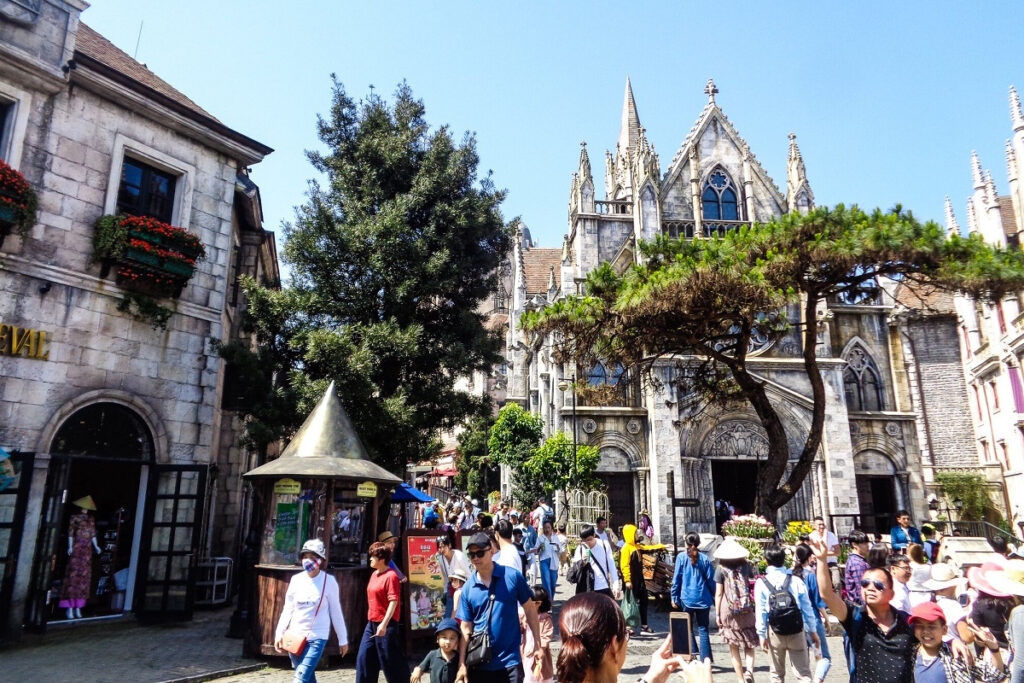
Ba Na Hills Cable Car Schedule
Ba Na Hills cable car is operated from 7:30 a.m to 9:30 p.m daily, but most frequently before 5:30 p.m. Its lines have their own reschedule that depends on weather, maintenance and number of tourists in the day. In the high seasons, should follow the crowds or tour guides, to get the operating station easiest for reaching up the mountain resort.
Line 4 usually opens earliest because it provides the quickest ride to the Golden bridge and surrounding flower gardens. Morning is the best time to visit them. Moreover, sightseeing in that area first serves the convenience in travel itinerary too. Nearly all of the restaurants and outdoor celebrations occur in another zone, so if “done” things to see and do there, it’s unnecessary to go back anymore. Last cabin leaving Line 4 departure station is between 11:30 and 11:45 a.m. Line 1 is operated many times during the peak seasons, to support Line 4. In the late afternoon, Line 4 reopens, to solve the congestion in French village.
In the midday, cabins in Line #3 start moving to take visitors straight to the French village where restaurants are served and live performances occur. In later hours, visitors also get these to go down the mountain, because of being without transit. After 5, the frequency of Line 3 is changed, caused by decreasing number of tourists. At the time, passengers (up) were chiefly travelers who stayed over in Ba Na Hills hotel. If planning to explore the hill station at night, Line 3 is the only choice to return.
Reschedule of Ba Na Hills cable car is changeable. Therefore, the top tip is that you should have a double check with the staff right in the place, to ensure opening and closing times of all lines made sense.

Ba Na Hills Cable Car Tickets
Ba Na Hills Cable Car Cost
Ba Na hill station cable car price is 850,000 VND for adults and teenagers above 1,4 meters in height. For childrens from 1 to 1,4 meters, it’s 700,000 VND and for smaller ages, it’s free of charge. Because of being exactly the same as Ba Na Hills entrance fee, travelers just need to reserve or buy an official ticket to experience the rides. All local tour operators, booking desks, tourist information centers and travel agents can book with the same price. Besides, tickets are also available in online sites, with a cheaper cost at some times (promotion in low season). On the webpage of Sun World Ba Na Hills, travelers can buy it too.
No matter which places you buy, it’s necessary to come to the counters near Ba Na Hills cable car stations to exchange physical tickets. In the high season, full booking seems to never occur, so you don’t need to reserve in advance but definitely stand in long lines in front of the counters anyway. Several big online booking channels deal with the owner company to help their customers skip the queues. Asking directly to know whether you have that policy or not.
Ticket Counters
Ba Na Hills cable car ticket counters are to the right of the main walkway (leading to the bridge and a big gate). Cash in Vietnam dong is preferred there, but if have not enough, it’s possible to have an exchange from USD. Don’t expect the rate to be high, because the counters are far from any banks. In high seasons, long queues before the cashiers often occur and to save time, should book a ticket online. If you travel on rainy days, the weather in the mountain is clearly shown in screens nearby. See how the weather is before purchasing the ticket. In the afternoon, do the same to avoid disappointments.
Ba Na Hills Cable Car Ticket Reservation
Local travel agencies can help to reserve Ba Na hills cable car tickets in advance for tourists. In high seasons or weekend, a reservation assists to skip long queues at ticket counters. Text us in whatsapp number +84968009827 to make it.
Luggage Storage
Luggage storage is necessary if you travel Ba Na Hills with suitcases and bags, especially when heading over straight away after hotel check out or an airport arrival. This convenience is provided for free and available from 8 a.m to 9 p.m. A numbered tag will be given for verifying later.
Parking Lot
Parking lots for free are many to park your bicycle near the traffic circle at Ba Na Hills’s entrance gate (not the one by the golf course). Simply, just ride along Ba Na-Suoi Mo road and when you can’t ride further, the staff will show the direction to come to the right place. The keepers give to the riders a card with a number, and when returning, the holders have to show it for the authentication. In high seasons, motorcycles may be so many, therefore you should remember the license plate to find it easier. After taking the card, walk to the left and the ticket counters are to the right. Don’t come in the Big gate, the counters are nearer than you think.
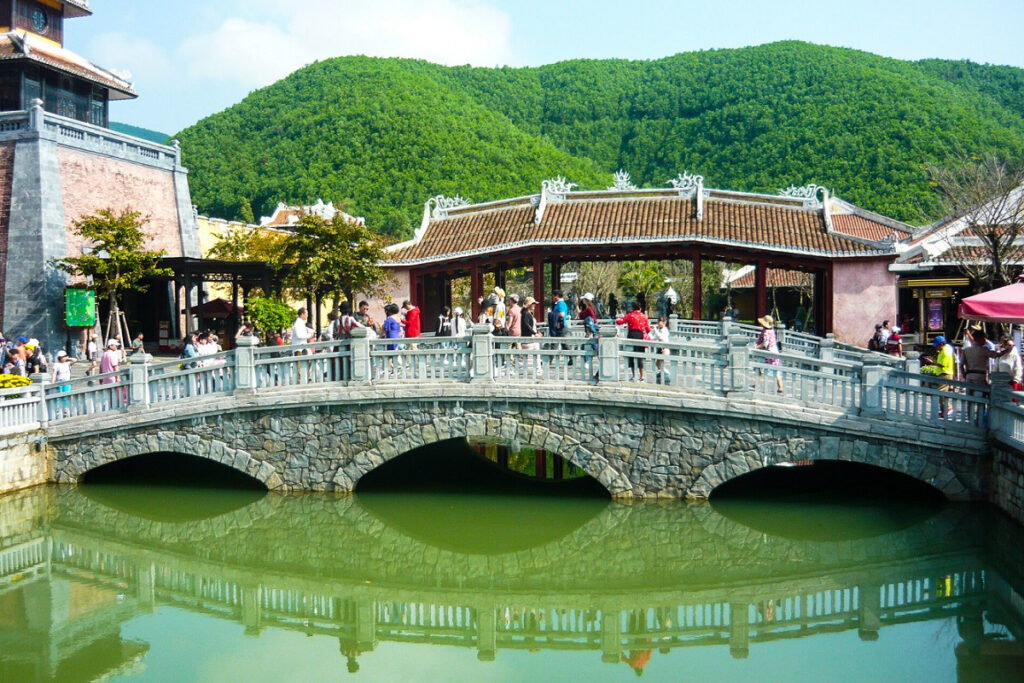
Experience during Ba Na Hills Cable Car Ride
Experience during a cable car ride in Ba Na Hills is worth a trip, first of all because of the picteresque natural scenery. Passengers can expect to see green hills below the cabin to purple mountains near the horizon, small to huge outcrops, high waterfalls, streams, reservoirs, big and ancient trees, animals and blooming flowers at some times. Most of them hide and show during the ups and downs of the cabin. Don’t forget to look back, whole of Da Nang plain, mountains, villages and nearby sea are in your sight. The best time to see it is in the morning when the waters become shimmering. In the evening, millions of lights in the city impress any travelers.
This scenic and well-preserved landscape is enriched by weather phenomena like clouds, fogs, and rainbows. The most seen one is the cloud that when the cabin moves through, it seems to be in a different world. On many days, from the mountaintop, the sea of clouds is visible and making the attraction become a surreal island. Some issues passengers may encounter (because of altitude change) also are extra factors to make the ride more interesting. Of course, fresh air and photo opportunities are provided all the time.
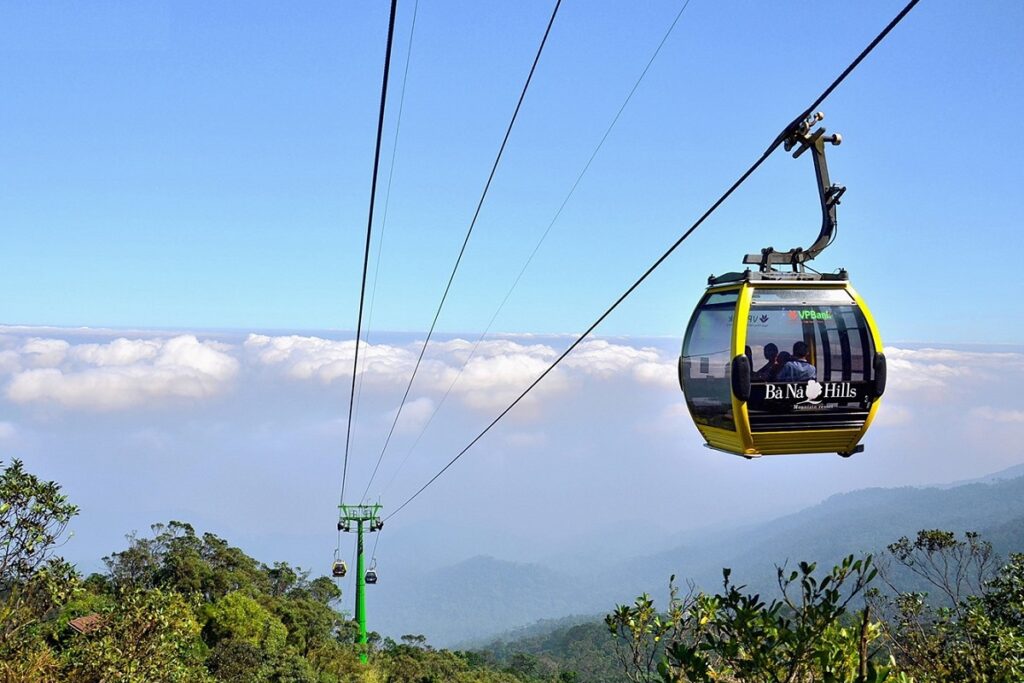
Cabin of Ba Na Hills Cable Car – A Review
Ba Na Hills cable car lines have different numbers of cabins and individually, each cabin has a different capacity. The main reason is that they were constructed at different times in history. Cabins on the first line (Line 1) house from 6 to 8 people, but it can be up to 30 for the newest line. While all passengers sit close together in an arc in the earliest-operated cabins, the later ones allow passengers to sit in two rows parallel and facing each other. There is one door only and it’s closed and opened automatically. Manually-opened windows are available, at least 2 in each cabin, to allow passengers to breathe the clean air during the ride. In Line 3, glass floors can be seen, but just some. Travelers are advised to put the phone out the window to take photos or stand on the settings.
Additionally, sick bags and maps in several languages are also added for free (usually Vietnamese, English, Chinese, and Korean). Not always, the music or introduction about the destination is on, really nice to listen to. In bad weather (like thunder), the cabin may stop to ensure safety for passengers. How long it occurs depends on weather conditions, of course. So, if meet this situation, should be calm because the engineers know it and do their best to reoperate safely the cable car. If possible, experience in a sunny day.
Changes During Ba Na Hills Cable Car Ride
Passengers may encounter some small issues while being on Ba Na Hills cable car, caused by sudden changes in elevation, air pressure, and temperature. Tinnitus is most popular and then to little headache and nervousness. Although all feelings last not long, children and kids may be scare of that. The easiest change to guess is about temperature. It’s so different between the hill station and city, commonly 10oC difference.
The Best Time to Get Ba Na Hills Cable Car
An experience with a cable car in Ba Na Hills is one of the most unforgettable memories in Da Nang. It’s loved and popular by nearly all tourists traveling to the city, so it is usually busy. During the high seasons, the stations are packed. Therefore, plenty of travelers try to arrive early to avoid the crowds. When the temperature decreases in late hours of the afternoon, they move down the mountain and go back to the hotel. However, this itinerary is not really unpopular. Organized tours and bloggers recommend the same, so the line is still long but shorter than in the midday.
The evening is also nice, because at that time, it’s cooler, peaceful and there are no long queues anywhere. Repeat visitors often like it, but for first timers, should sightsee in the daytime when all sights still open, activites still occur and the landscape is visible. About the months, avoid stormy days in the end of the year. Cable car may be stopped operating to ensure passengers safety. Sceneries are “hidden” by brown clouds.
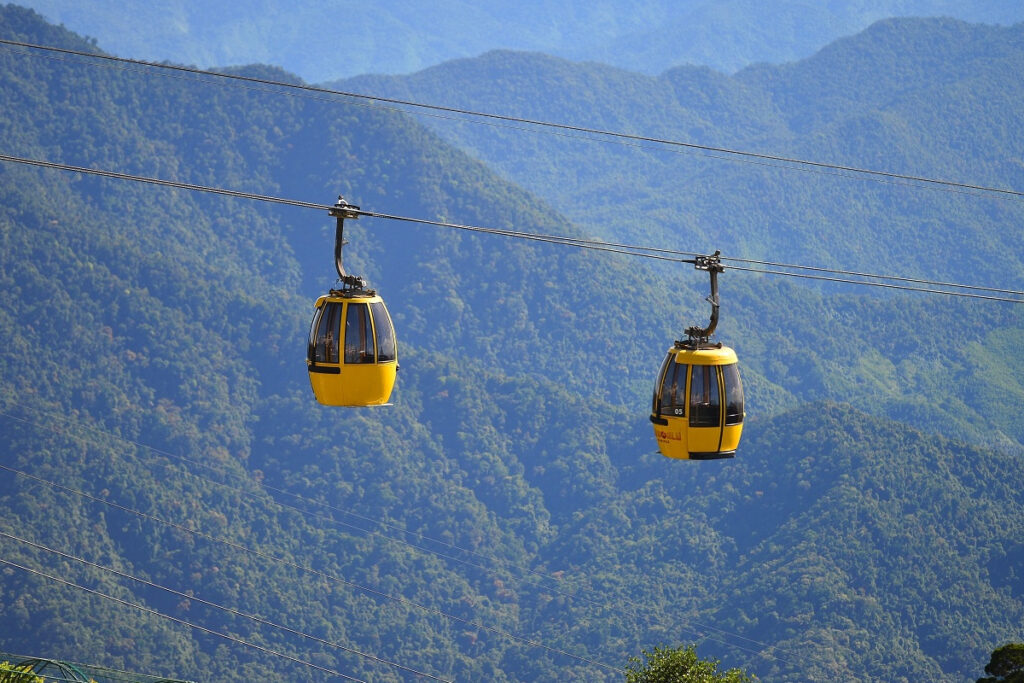
Why Build Cable Car to Ba Na Hills?
Different from many Da Nang tourist attractions, Ba Na Hills is located on the top of a mountain range. In colonial times, French built a road leading to it, but small and bumpy, and that one was abandoned when the colonists left. In the 1990s, leaders of local committees put their care into the hill station to develop tourism. So, the former road was improved and enlarged, allowing transportation by cars and mini vans. However, the ride up the mountain is still long and potentially dangerous because of dense fog. In 2009, the first Ba Na Hills cable car was inaugurated to solve problems that visitors had faced previously. Cable cars serve quicker and safer rides. On the other side, this addition helps to prevent forests from cutting down to widen roads and reduce air pollution. Wildlife under the cabins is among the richest one in the region.
Ba Na Hills Cable Car – Lost and Found
If passengers forget a personal belonging or lost something in the cabin, they should announce it to any staff near them first. Responsible persons in the cable car network will check cameras to help to find out quickly then. However, many visitors remember they left something when they were already at the hotel or somewhere far from the hills. In that case, it’s necessary to let the customer service know via contacts in Ba Na Hills’s official sites. When found, the staff will let the loser know or help to send home upon the request. On the way from cable car stations to the parking lots, travelers may see “lost and found” corner. Owner of the items kept there may don’t realize the loss or may come to get one day.
Brothers and Sisters of Ba Na Hills Cable Car
Ba Na Hills cable car lay a foundation for Sun World’s cable car network that is present in many tourist destinations around Vietnam. Its younger siblings are the Fansipan Legend in Sapa, Cat Ba island, Hon Thom island in Phu Quoc, Baden Mountain and Ha Long Bay.
Ba Na Hills Cable Cars Map
Related Posts
Non Nuoc Beach: The Famous Beach of Da Nang
Besides the Golden hands bridge – a global hit, Da Nang city also has beautiful beaches. If looking for somewhere great to stay and have a slow holiday, Non Nuoc
How to Get from Da Nang to My Son Sanctuary
Known as ‘the Angkor Wat of Vietnam’, My Son sanctuary boasts of its sophisticated temples dating back from 4th century. Sadly, in 14th century, it’s abandoned in the forests. Today,
Bach Ma National Park: Hiking, Trekking in Da Nang and Hoi An
Two best places for trekking and hiking in and near Da Nang are Son Tra mountain (peninsula) and Bach Ma national park. Which one is better is actually personal because these
Am Phu Cave (Hell Cave) – Things to Do in Da Nang
Although in the Marble mountains – the most visited attraction in Da Nang, travelers often miss Am Phu cave. One of reasons is that it’s mentioned much online and not
Asia Park and Sun Wheel in Da Nang (Sun World Da Nang Wonders)
Have you ever seen the wheel of Da Nang? That is the Sun Wheel. It’s a part of greater Asia Park – an amusement park with a heap of fun
How to Get to Golden Bridge from Da Nang
The Golden Bridge (aka the Golden Hands Bridge) in Da Nang is a must visit attraction in Vietnam today. Many foreign travelers come to the city, just because they love
Da Nang Food Specialties: What to Eat in Da Nang
Da Nang is known as a food capital of central Vietnam. This city boasts many yummy dishes, prepared by distinctive recipes and some of them are famous all over the
How to Visit Golden Bridge Vietnam
The Golden Hand Bridge of Ba Na hills today is a dream place to visit for many travelers. Since it opened in June 2018, millions of people have set their
Da Nang Shore Excursions: Guided Tours From Tien Sa Port
Da Nang Vietnam today is one of stopovers for many cruises that travel from continent to continent, from country to country. It owns an ideal seaport to moor and it
Han Market (Cho Han): Where to Shop in Da Nang?
In the heart of Da Nang, the Han market is a popular place for visitors to buy something to bring home due to the diversity of merchandise. Back to history,
Da Nang Cathedral (Da Nang Pink Church)
Da Nang became a French protectorate on 3rd October 1888, under the name “Tourane”. By the Han river, the colonists designed a grid of streets with public buildings, a city hall,
Things to Do in Ba Na Hills Besides Golden Bridge
According to local authorities, 50% of visitors coming to Da Nang and Hoi An visit the Ba Na hills. In other words, that is nearly 10 millions of people. This
Da Nang Half Day Tours
In addition to day trips, travelers have many options of half-day tours in Da Nang to choose from. Not to spend a full day at different places, maybe far from
Da Nang Private Car and Driver
Your next holiday destination is Da Nang? You prefer to travel by yourself? Hiring a private car is one of the best options for you to explore with freedom, flexibility
Da Nang and Hoi An Itinerary for Visitors Staying Overnight in Hoi An
Da Nang and Hoi An are twin cities in the heart of Central Vietnam. Both are popular tourist destinations for either domestic or international visitors, and share many similarities. Due
Da Nang Things to Do: Guide to What to Do in Da Nang Vietnam
Unquestionably, Da Nang deserves a holiday trip from all types of traveller. Firstly, due to the weather. It has a longer sunny time than the north but less hot than
Da Nang Best Things to Do and Reasons
Da Nang is the largest tourist center in Central Vietnam. It owns fascinating natural and cultural places that attract both Vietnamese and foreigners. In the busiest year, this city of
How to Get From Hoi An to Da Nang
Da Nang is the neighbouring city of Hoi An. It's the capital of Central Vietnam and has the most important (busiest) transport hubs of the region, such as airport, train
Hoi An or Da Nang: Which is Better for First Time Visitor?
Da Nang and Hoi An are located in Central Vietnam, with a distance of roughly 30 km. To the north, Da Nang is the capital city of the region, with
My Son Sanctuary Tour
My Son Sanctuary is a Unesco world heritage site, attracting 450,000 visitors in recent years. It’s the best remains left by the fallen Champa Kingdom which ruled a part of
Da Nang Best Area to Stay: Guide to Where to Stay in Da Nang
In the Central coast, Da Nang has an area of 1,285 km2 and population of 1,134 people, making it become Vietnam’s 4th largest city. It plays an important role in the
Da Nang Cave Tour: Best Underground Activities in Da Nang
Different from Hue and Hoi An, Da Nang has limestone caves and grottoes. All of them are within the Marble Mountains (Ngu Hanh Son), a complex of 5 amazing hills
Da Nang Best Time to Visit: Guide to Best Weather in Da Nang
Da Nang is titled “Asia’s leading festival and event destination” by the World Travel Awards or Vietnam’s greenest city by the WWF. Its reputation comes from amazing natural mountain-to-sea sceneries,
Da Nang Weather by Month: Guide to Monthly Weather in Da Nang
In Central Vietnam, Da Nang has a tropical monsoon climate with two distinct seasons that each starts later than the North 2 months. Because of being shielded by the spectacular
What to Do in Da Nang At Night
Between the sunset and midnight, there are many things to do in Da Nang that travelers should know before getting to bed. Thankfully, different styles of traveling, budget or ages
Lang Co Vietnam Travel Guide
Lang Co was a lovely backwater town nestled at the foot of spectacular Hai Van Pass for some decades. Not yet widely known because of the popularity of beaches in
What to Do in Da Nang for 3 Days
Da Nang is a lovely coastal city in the middle of 3 Unesco world heritages Hue, Hoi An and My Son Sanctuary. This most worth-living municipality owns a poetic river
My Khe Beach: A Complete Guide to Da Nang’s Best Beach
Da Nang is a lovely seaside city with many beaches, and the best is My Khe. Located on the eastern coastline, it’s between little-known beaches near the foot of Son
Da Nang Day Trips: Guide to Best Day Tours From Da Nang
Centre and outskirts of Da Nang have incredible attractions where travellers need to spend many hours to get to and fully explore. There are the Ba Na Hills and Golden
Museums in Da Nang
Da Nang has many museums where visitors can see and learn a lot. Generally, their exhibitions have different themes, varying in stages of the history, groups of people (communities) having
Linh Ung Pagoda: Trio of Da Nang’s Holiest Mountain Temples
Linh Ung means “wishes answered miraculously” in Sino-Vietnamese. And it’s first used in 1841 to name a pagoda in the Marble Mountains by Thanh Thai, the 10th king of the
Da Nang Night Market: A Thing To Do in Da Nang at Night
Different from day markets in Da Nang, night markets are held open-air and on streets where traffic is active during sunny hours. A visit there provides the chance to understand
Guide to Son Tra Mountain (Monkey Mountain) in Da Nang, Vietnam
From My Khe Beach or Han River promenades, tourists can see a part of the Son Tra Mountain. Although being near the city center, natural forests on its slopes have
Ba Na Hills Tour
Ba Na Hills is one of the best attractions in Da Nang, and the country. Its full name is the Ba Na-Suoi Mo Tourist Area, made from “Ba Na hill
Da Nang Cable Car
No surprise that now, when travelers make the plan to tour around Vietnam, there are many cable car rides recommended. Some are top things to do in its cities. The
How to Get from Da Nang Airport to Hoi An
Located in the city of the same name, Da Nang airport is the nearest airport to Hoi An. So, if travelers want to see an extremely-colorful Lantern festival or try
Da Nang to Hoi An: Best Da Nang Airport Transfer and More
If traveling to Hoi An by air, train and cruise ship, visitors will come to Da Nang first and then have a transfer. The largest city of Central Vietnam holds
Hai Van Pass Da Nang: Map, Route, Weather, History, Tour
Truong Son or Annamite Range is the most dramatic mountain ridge in Vietnam. When it juts out into the sea, spectacular Hai Van Pass is formed. This amazing sculpture of
Da Nang Attractions Guide: What to See in Da Nang Vietnam?
Da Nang is the capital city of the Central region, and one of the most attractive destinations to tourists in Vietnam. It’s established by French colonists and called by them
Guide to Lady Buddha (Goddess of Mercy) in Monkey Mountain, Da Nang
From the East coast, visitors can see an enormous white statue with the mountain backdrop, that is the Lady Buddha Da Nang. Located in the ground of Linh Ung Pagoda,
My Son Sanctuary Travel Guide
My Son Sanctuary is a complex of Hindu temples and a Unesco world heritage site from 1999. It’s 40 km away from Hoi An and 70 km to the southwest
Da Nang Museum of Cham Sculpture
Da Nang Museum of Cham Sculpture is a highlight of the Han river waterfront. It’s established by French archaeologists to preserve intricate works of art of Champa kingdom, which ruled
Dragon Bridge Da Nang: The Fire-Breathing Da Nang Bridge
Praised to be the world's 30 most unique bridges recently, Dragon Bridge became the new icon for a Han river bridge in Da Nang. Spanning from the 100-years-old Cham Museum,
Ba Na Hills Travel Guide: A First Timer’s Complete Guide
50% of visitors to Da Nang plan to visit Ba Na Hills in their itinerary. It’s larger for first timers who may know about its inspirational Golden Bridge, world-record cable
Golden Bridge Da Nang: A Guide to The Iconic Da Nang Bridge
Recently-built but at the present time, the Golden Bridge Da Nang is one of the awaited attractions in Vietnam. On a slope of high foggy mountain, this delicate bridge and
Da Nang Bridge: A Guide to Famous Bridges in Da Nang
Da Nang has many bridges, and some of them are famous nationally and internationally. Before the recently-built Golden Bridge which made a boom in social media, people only knew bridges
Ba Na Hills Cable Car: World Record, Cost, Reschedule, Map
Cable car is one of the first ideas travelers think about Ba Na Hills, a Da Nang’s top attraction. It helps to shorten the time to get to the hills
Da Nang Mountain Temple: Marble Mountain’s Pagodas, More
Da Nang has many mountain temples where handmade architecture, natural sceneries and religious values are combined perfectly. So, travelers will see, enjoy and learn a lot about different things just
Da Nang Caves: Underground World of the Marble Mountains
One of the priceless gifts Mother nature gives to Da Nang is an array of caves and caverns. Almost all are located in the Marble Mountains, a complex of
The Marble Mountains: Guide to Da Nang’s Iconic Mountain
Had been an offshore group of islands, geological activities shifted the Marble Mountains to the land some thousands of years before. Today, its marble hills rise suddenly up to over 100
